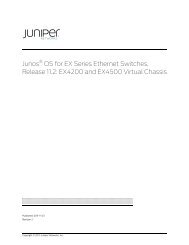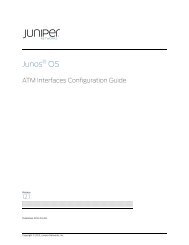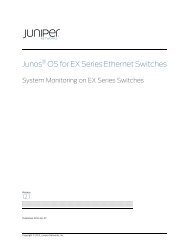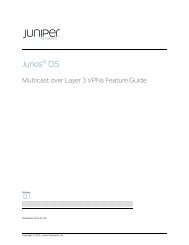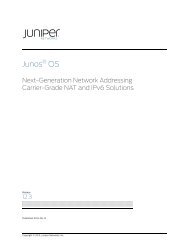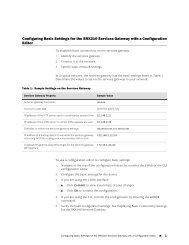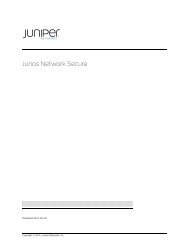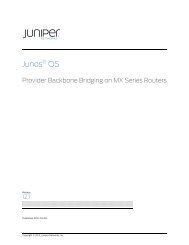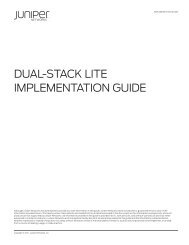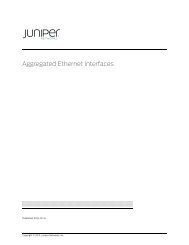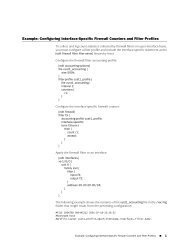Spanning Tree Protocol on Juniper Networks MX Series 3D ...
Spanning Tree Protocol on Juniper Networks MX Series 3D ...
Spanning Tree Protocol on Juniper Networks MX Series 3D ...
Create successful ePaper yourself
Turn your PDF publications into a flip-book with our unique Google optimized e-Paper software.
Technology Overview<br />
<str<strong>on</strong>g>Spanning</str<strong>on</strong>g> <str<strong>on</strong>g>Tree</str<strong>on</strong>g> <str<strong>on</strong>g>Protocol</str<strong>on</strong>g><br />
<strong>on</strong> <strong>Juniper</strong> <strong>Networks</strong> <strong>MX</strong> <strong>Series</strong> <strong>3D</strong> Universal Edge<br />
Routers<br />
Release<br />
13.1<br />
Published: 2013-02-08<br />
Copyright © 2013, <strong>Juniper</strong> <strong>Networks</strong>, Inc.
<strong>Juniper</strong> <strong>Networks</strong>, Inc.<br />
1194 North Mathilda Avenue<br />
Sunnyvale, California 94089<br />
USA<br />
408-745-2000<br />
www.juniper.net<br />
This product includes the Envoy SNMP Engine, developed by Epilogue Technology, an Integrated Systems Company. Copyright © 1986-1997,<br />
Epilogue Technology Corporati<strong>on</strong>. All rights reserved. This program and its documentati<strong>on</strong> were developed at private expense, and no part<br />
of them is in the public domain.<br />
This product includes memory allocati<strong>on</strong> software developed by Mark Moraes, copyright © 1988, 1989, 1993, University of Tor<strong>on</strong>to.<br />
This product includes FreeBSD software developed by the University of California, Berkeley, and its c<strong>on</strong>tributors. All of the documentati<strong>on</strong><br />
and software included in the 4.4BSD and 4.4BSD-Lite Releases is copyrighted by the Regents of the University of California. Copyright ©<br />
1979, 1980, 1983, 1986, 1988, 1989, 1991, 1992, 1993, 1994. The Regents of the University of California. All rights reserved.<br />
GateD software copyright © 1995, the Regents of the University. All rights reserved. Gate Daem<strong>on</strong> was originated and developed through<br />
release 3.0 by Cornell University and its collaborators. Gated is based <strong>on</strong> Kirt<strong>on</strong>’s EGP, UC Berkeley’s routing daem<strong>on</strong> (routed), and DCN’s<br />
HELLO routing protocol. Development of Gated has been supported in part by the Nati<strong>on</strong>al Science Foundati<strong>on</strong>. Porti<strong>on</strong>s of the GateD<br />
software copyright © 1988, Regents of the University of California. All rights reserved. Porti<strong>on</strong>s of the GateD software copyright © 1991, D.<br />
L. S. Associates.<br />
This product includes software developed by Maker Communicati<strong>on</strong>s, Inc., copyright © 1996, 1997, Maker Communicati<strong>on</strong>s, Inc.<br />
<strong>Juniper</strong> <strong>Networks</strong>, Junos, Steel-Belted Radius, NetScreen, and ScreenOS are registered trademarks of <strong>Juniper</strong> <strong>Networks</strong>, Inc. in the United<br />
States and other countries. The <strong>Juniper</strong> <strong>Networks</strong> Logo, the Junos logo, and JunosE are trademarks of <strong>Juniper</strong> <strong>Networks</strong>, Inc. All other<br />
trademarks, service marks, registered trademarks, or registered service marks are the property of their respective owners.<br />
<strong>Juniper</strong> <strong>Networks</strong> assumes no resp<strong>on</strong>sibility for any inaccuracies in this document. <strong>Juniper</strong> <strong>Networks</strong> reserves the right to change, modify,<br />
transfer, or otherwise revise this publicati<strong>on</strong> without notice.<br />
Products made or sold by <strong>Juniper</strong> <strong>Networks</strong> or comp<strong>on</strong>ents thereof might be covered by <strong>on</strong>e or more of the following patents that are<br />
owned by or licensed to <strong>Juniper</strong> <strong>Networks</strong>: U.S. Patent Nos. 5,473,599, 5,905,725, 5,909,440, 6,192,051, 6,333,650, 6,359,479, 6,406,312,<br />
6,429,706, 6,459,579, 6,493,347, 6,538,518, 6,538,899, 6,552,918, 6,567,902, 6,578,186, and 6,590,785.<br />
Technology Overview <str<strong>on</strong>g>Spanning</str<strong>on</strong>g> <str<strong>on</strong>g>Tree</str<strong>on</strong>g> <str<strong>on</strong>g>Protocol</str<strong>on</strong>g><br />
<strong>on</strong> <strong>Juniper</strong> <strong>Networks</strong> <strong>MX</strong> <strong>Series</strong> <strong>3D</strong> Universal Edge Routers<br />
Release 13.1<br />
NCE0011<br />
Copyright © 2013, <strong>Juniper</strong> <strong>Networks</strong>, Inc.<br />
All rights reserved.<br />
The informati<strong>on</strong> in this document is current as of the date <strong>on</strong> the title page.<br />
YEAR 2000 NOTICE<br />
<strong>Juniper</strong> <strong>Networks</strong> hardware and software products are Year 2000 compliant. Junos OS has no known time-related limitati<strong>on</strong>s through the<br />
year 2038. However, the NTP applicati<strong>on</strong> is known to have some difficulty in the year 2036.<br />
END USER LICENSE AGREEMENT<br />
The <strong>Juniper</strong> <strong>Networks</strong> product that is the subject of this technical documentati<strong>on</strong> c<strong>on</strong>sists of (or is intended for use with) <strong>Juniper</strong> <strong>Networks</strong><br />
software. Use of such software is subject to the terms and c<strong>on</strong>diti<strong>on</strong>s of the End User License Agreement (“EULA”) posted at<br />
http://www.juniper.net/support/eula.html. By downloading, installing or using such software, you agree to the terms and c<strong>on</strong>diti<strong>on</strong>s<br />
of that EULA.<br />
ii<br />
Copyright © 2013, <strong>Juniper</strong> <strong>Networks</strong>, Inc.
Table of C<strong>on</strong>tents<br />
Introducti<strong>on</strong> . . . . . . . . . . . . . . . . . . . . . . . . . . . . . . . . . . . . . . . . . . . . . . . . . . . . . . . . . 1<br />
Overview of <str<strong>on</strong>g>Spanning</str<strong>on</strong>g> <str<strong>on</strong>g>Tree</str<strong>on</strong>g> <str<strong>on</strong>g>Protocol</str<strong>on</strong>g> <strong>on</strong> <strong>Juniper</strong> <strong>Networks</strong> <strong>MX</strong> <strong>Series</strong> <strong>3D</strong> Universal<br />
Edge Routers . . . . . . . . . . . . . . . . . . . . . . . . . . . . . . . . . . . . . . . . . . . . . . . . . . . . 1<br />
<str<strong>on</strong>g>Spanning</str<strong>on</strong>g> <str<strong>on</strong>g>Tree</str<strong>on</strong>g> <str<strong>on</strong>g>Protocol</str<strong>on</strong>g> Operati<strong>on</strong> . . . . . . . . . . . . . . . . . . . . . . . . . . . . . . . . . . . . . . 2<br />
Key C<strong>on</strong>cepts in <str<strong>on</strong>g>Spanning</str<strong>on</strong>g> <str<strong>on</strong>g>Tree</str<strong>on</strong>g> <str<strong>on</strong>g>Protocol</str<strong>on</strong>g>s . . . . . . . . . . . . . . . . . . . . . . . . . . . . . . . . . 4<br />
Port Roles in STP . . . . . . . . . . . . . . . . . . . . . . . . . . . . . . . . . . . . . . . . . . . . . . . . . . . . 5<br />
Decisi<strong>on</strong> Sequence for a Loop-Free STP Topology . . . . . . . . . . . . . . . . . . . . . . . . . . 6<br />
<str<strong>on</strong>g>Spanning</str<strong>on</strong>g> <str<strong>on</strong>g>Tree</str<strong>on</strong>g> <str<strong>on</strong>g>Protocol</str<strong>on</strong>g> States . . . . . . . . . . . . . . . . . . . . . . . . . . . . . . . . . . . . . . . . . 7<br />
Rapid <str<strong>on</strong>g>Spanning</str<strong>on</strong>g> <str<strong>on</strong>g>Tree</str<strong>on</strong>g> <str<strong>on</strong>g>Protocol</str<strong>on</strong>g> Port States and Port Roles . . . . . . . . . . . . . . . . . . . 10<br />
Multiple <str<strong>on</strong>g>Spanning</str<strong>on</strong>g> <str<strong>on</strong>g>Tree</str<strong>on</strong>g> <str<strong>on</strong>g>Protocol</str<strong>on</strong>g> . . . . . . . . . . . . . . . . . . . . . . . . . . . . . . . . . . . . . . . 14<br />
VLAN <str<strong>on</strong>g>Spanning</str<strong>on</strong>g> <str<strong>on</strong>g>Tree</str<strong>on</strong>g> <str<strong>on</strong>g>Protocol</str<strong>on</strong>g> . . . . . . . . . . . . . . . . . . . . . . . . . . . . . . . . . . . . . . . . . 18<br />
STP Scaling and Performance <strong>on</strong> <strong>Juniper</strong> <strong>Networks</strong> <strong>MX</strong> <strong>Series</strong> <strong>3D</strong> Universal Edge<br />
Routers . . . . . . . . . . . . . . . . . . . . . . . . . . . . . . . . . . . . . . . . . . . . . . . . . . . . . . . 22<br />
Restricti<strong>on</strong>s and Cauti<strong>on</strong>s for Implementing STP . . . . . . . . . . . . . . . . . . . . . . . . . . 23<br />
Copyright © 2013, <strong>Juniper</strong> <strong>Networks</strong>, Inc.<br />
iii
<str<strong>on</strong>g>Spanning</str<strong>on</strong>g> <str<strong>on</strong>g>Tree</str<strong>on</strong>g> <str<strong>on</strong>g>Protocol</str<strong>on</strong>g><br />
<strong>on</strong> <strong>Juniper</strong> <strong>Networks</strong> <strong>MX</strong> <strong>Series</strong> <strong>3D</strong> Universal Edge Routers<br />
iv<br />
Copyright © 2013, <strong>Juniper</strong> <strong>Networks</strong>, Inc.
Introducti<strong>on</strong><br />
This Technology Overview describes and compares the <str<strong>on</strong>g>Spanning</str<strong>on</strong>g> <str<strong>on</strong>g>Tree</str<strong>on</strong>g> <str<strong>on</strong>g>Protocol</str<strong>on</strong>g> versi<strong>on</strong>s<br />
supported <strong>on</strong> <strong>MX</strong> <strong>Series</strong> <strong>3D</strong> Universal Edge Routers.<br />
This document helps you decide which STP versi<strong>on</strong> can and should be used <strong>on</strong> your <strong>MX</strong><br />
<strong>Series</strong> routers to ensure a loop-free topology.<br />
Overview of <str<strong>on</strong>g>Spanning</str<strong>on</strong>g> <str<strong>on</strong>g>Tree</str<strong>on</strong>g> <str<strong>on</strong>g>Protocol</str<strong>on</strong>g> <strong>on</strong> <strong>Juniper</strong> <strong>Networks</strong> <strong>MX</strong> <strong>Series</strong> <strong>3D</strong> Universal Edge<br />
Routers<br />
The <str<strong>on</strong>g>Spanning</str<strong>on</strong>g> <str<strong>on</strong>g>Tree</str<strong>on</strong>g> <str<strong>on</strong>g>Protocol</str<strong>on</strong>g> (STP) is defined in the Institute of Electrical and Electr<strong>on</strong>ics<br />
Engineers (IEEE) Standard 802.1D. STP examines the network topology and calculates<br />
a spanning-tree structure that encompasses all bridges in a given Layer 2 network domain.<br />
It can disable redundant paths by pruning links that are not part of the tree, leaving a<br />
unique single path from each source to any other destinati<strong>on</strong> in the network.<br />
STP c<strong>on</strong>sists of distance vector protocols that use distance or hop count as the primary<br />
metric for determining the best forwarding path. It uses maximum-age parameters to<br />
help avoid loops that count to infinity.<br />
This document describes the major <str<strong>on</strong>g>Spanning</str<strong>on</strong>g> <str<strong>on</strong>g>Tree</str<strong>on</strong>g> <str<strong>on</strong>g>Protocol</str<strong>on</strong>g> versi<strong>on</strong>s supported <strong>on</strong> <strong>Juniper</strong><br />
<strong>Networks</strong> <strong>MX</strong> <strong>Series</strong> <strong>3D</strong> Universal Edge Routers using Junos OS Release 8.4 or later,<br />
including:<br />
• <str<strong>on</strong>g>Spanning</str<strong>on</strong>g> <str<strong>on</strong>g>Tree</str<strong>on</strong>g> <str<strong>on</strong>g>Protocol</str<strong>on</strong>g> (STP), specified in IEEE 802.1D 1998<br />
• Rapid <str<strong>on</strong>g>Spanning</str<strong>on</strong>g> <str<strong>on</strong>g>Tree</str<strong>on</strong>g> <str<strong>on</strong>g>Protocol</str<strong>on</strong>g> (RSTP), specified in IEEE 802.1w; standardized in IEEE<br />
802.1D 2004<br />
• Multiple <str<strong>on</strong>g>Spanning</str<strong>on</strong>g> <str<strong>on</strong>g>Tree</str<strong>on</strong>g> <str<strong>on</strong>g>Protocol</str<strong>on</strong>g> (MSTP), specified in IEEE 802.1s; standardized in IEEE<br />
802.1Q 2003<br />
• Virtual LAN <str<strong>on</strong>g>Spanning</str<strong>on</strong>g> <str<strong>on</strong>g>Tree</str<strong>on</strong>g> <str<strong>on</strong>g>Protocol</str<strong>on</strong>g> (VSTP), <strong>Juniper</strong> <strong>Networks</strong> soluti<strong>on</strong> for using STP<br />
with multiple VLANs<br />
Both <strong>Juniper</strong> <strong>Networks</strong> EX <strong>Series</strong> Ethernet Switches and <strong>MX</strong> <strong>Series</strong> routers run Junos OS<br />
and support a similar set of Layer 2 features with some variati<strong>on</strong>s. The EX <strong>Series</strong> switches<br />
running Junos OS Release 10.2 or later support: STP, RSTP, MSTP, and VSTP. VSTP is<br />
compatible with Per-VLAN <str<strong>on</strong>g>Spanning</str<strong>on</strong>g> <str<strong>on</strong>g>Tree</str<strong>on</strong>g> Plus (PVST+) and Rapid-PVST+ protocols<br />
supported <strong>on</strong> other vendors’ routers and switches.<br />
Understanding the Requirement for <str<strong>on</strong>g>Spanning</str<strong>on</strong>g> <str<strong>on</strong>g>Tree</str<strong>on</strong>g> <str<strong>on</strong>g>Protocol</str<strong>on</strong>g>s<br />
<strong>MX</strong> <strong>Series</strong> routers are used for deploying Layer 2 bridged networks. STPs are essential<br />
for these types of deployments, where they are used for allowing Layer 2 bridged networks<br />
to include spare, redundant links that provide automatic backup paths if an active link<br />
fails. However, whenever there are redundant paths between a source and a destinati<strong>on</strong>,<br />
there is the potential for forwarding loops. Forwarding loops must be avoided because<br />
they result in broadcast storms in the network. STPs are required to block redundant<br />
forwarding paths to prevent forwarding loops.<br />
Copyright © 2013, <strong>Juniper</strong> <strong>Networks</strong>, Inc.<br />
1
<str<strong>on</strong>g>Spanning</str<strong>on</strong>g> <str<strong>on</strong>g>Tree</str<strong>on</strong>g> <str<strong>on</strong>g>Protocol</str<strong>on</strong>g><br />
<strong>on</strong> <strong>Juniper</strong> <strong>Networks</strong> <strong>MX</strong> <strong>Series</strong> <strong>3D</strong> Universal Edge Routers<br />
Related<br />
Documentati<strong>on</strong><br />
• Decisi<strong>on</strong> Sequence for a Loop-Free STP Topology <strong>on</strong> page 6<br />
• Key C<strong>on</strong>cepts in <str<strong>on</strong>g>Spanning</str<strong>on</strong>g> <str<strong>on</strong>g>Tree</str<strong>on</strong>g> <str<strong>on</strong>g>Protocol</str<strong>on</strong>g>s <strong>on</strong> page 4<br />
• Multiple <str<strong>on</strong>g>Spanning</str<strong>on</strong>g> <str<strong>on</strong>g>Tree</str<strong>on</strong>g> <str<strong>on</strong>g>Protocol</str<strong>on</strong>g> <strong>on</strong> page 14<br />
• Port Roles in STP <strong>on</strong> page 5<br />
• Rapid <str<strong>on</strong>g>Spanning</str<strong>on</strong>g> <str<strong>on</strong>g>Tree</str<strong>on</strong>g> <str<strong>on</strong>g>Protocol</str<strong>on</strong>g> Port States and Port Roles <strong>on</strong> page 10<br />
• Restricti<strong>on</strong>s and Cauti<strong>on</strong>s for Implementing STP <strong>on</strong> page 23<br />
• <str<strong>on</strong>g>Spanning</str<strong>on</strong>g> <str<strong>on</strong>g>Tree</str<strong>on</strong>g> <str<strong>on</strong>g>Protocol</str<strong>on</strong>g> Operati<strong>on</strong> <strong>on</strong> page 2<br />
• <str<strong>on</strong>g>Spanning</str<strong>on</strong>g> <str<strong>on</strong>g>Tree</str<strong>on</strong>g> <str<strong>on</strong>g>Protocol</str<strong>on</strong>g> States <strong>on</strong> page 7<br />
• STP Scaling and Performance <strong>on</strong> <strong>Juniper</strong> <strong>Networks</strong> <strong>MX</strong> <strong>Series</strong> <strong>3D</strong> Universal Edge Routers<br />
<strong>on</strong> page 22<br />
• VLAN <str<strong>on</strong>g>Spanning</str<strong>on</strong>g> <str<strong>on</strong>g>Tree</str<strong>on</strong>g> <str<strong>on</strong>g>Protocol</str<strong>on</strong>g> <strong>on</strong> page 18<br />
<str<strong>on</strong>g>Spanning</str<strong>on</strong>g> <str<strong>on</strong>g>Tree</str<strong>on</strong>g> <str<strong>on</strong>g>Protocol</str<strong>on</strong>g> Operati<strong>on</strong><br />
The <str<strong>on</strong>g>Spanning</str<strong>on</strong>g> <str<strong>on</strong>g>Tree</str<strong>on</strong>g> <str<strong>on</strong>g>Protocol</str<strong>on</strong>g> is used to create a loop-free topology in Layer 2 networks.<br />
It is a Layer 2 protocol that calculates the best path through a switched network that<br />
c<strong>on</strong>tains redundant paths.<br />
It allows bridges to communicate with each other for the purpose of discovering physical<br />
loops in the network. When physical loops are found, the protocol specifies an algorithm<br />
that bridges can use to create a loop-free logical topology. Blocking loops prevents<br />
broadcast storms in the network. The STP algorithm computes a tree structure of<br />
loop-free leaves and branches that spans the entire Layer 2 network.<br />
Various Layer 2 STP c<strong>on</strong>trol protocols take care of resolving the forwarding loops in a<br />
Layer 2 network. L2CPD is the Junos OS process resp<strong>on</strong>sible for all of the various STP<br />
versi<strong>on</strong>s in the Junos operating system.<br />
Figure 1 <strong>on</strong> page 3 shows a typical Layer 2 network in which broadcast loops can occur.<br />
2<br />
Copyright © 2013, <strong>Juniper</strong> <strong>Networks</strong>, Inc.
Figure 1: Flat Topology of Layer 2 Loops<br />
Host A<br />
R2<br />
R1<br />
R3<br />
Layer 2<br />
Loops<br />
Host B<br />
g040506<br />
In this example, STP is not enabled. Host A sends a frame to Host B to the broadcast<br />
MAC address (ff-ff-ff-ff-ff-ff). Router R2 (operating as a switch) receives the frame and<br />
sends it out to Router R1 and Router R3. When Router R1 and Router R3 receive the frame,<br />
they forward the frame to the Layer 2 switch c<strong>on</strong>nected to Host B. The Layer 2 switch<br />
then forwards the packet to the other router and to Host B. When Router R1 and Router<br />
R3 receive the frame, they forward the frame to Router R2. Router R2 forwards the frame<br />
to Host A, Router R1, and Router R2. Thus creating a forwarding loop.<br />
Loop preventi<strong>on</strong> in a Layer 2 Ethernet is handled differently than it is in Layer 3. A Layer<br />
3 IP header has a time-to-live (TTL) field that is set by the original host and is decremented<br />
at each router, allowing the router to prevent looped datagrams by discarding packets<br />
that reach TTL=0. This feature is not available for Layer 2 Ethernet frames.<br />
Therefore, after a Layer 2 frame starts to loop in the network shown in Figure 1 <strong>on</strong> page 3,<br />
it c<strong>on</strong>tinues looping forever until <strong>on</strong>e of these events occurs:<br />
• One of the bridges is turned off.<br />
• A link is broken.<br />
• A bridge is rebooted.<br />
Bridging tables that are not c<strong>on</strong>figured with STP can be corrupted by the looping created<br />
by a broadcast storm. Looping can also be created by unicast traffic.<br />
Copyright © 2013, <strong>Juniper</strong> <strong>Networks</strong>, Inc.<br />
3
<str<strong>on</strong>g>Spanning</str<strong>on</strong>g> <str<strong>on</strong>g>Tree</str<strong>on</strong>g> <str<strong>on</strong>g>Protocol</str<strong>on</strong>g><br />
<strong>on</strong> <strong>Juniper</strong> <strong>Networks</strong> <strong>MX</strong> <strong>Series</strong> <strong>3D</strong> Universal Edge Routers<br />
Related<br />
Documentati<strong>on</strong><br />
• Decisi<strong>on</strong> Sequence for a Loop-Free STP Topology <strong>on</strong> page 6<br />
• Key C<strong>on</strong>cepts in <str<strong>on</strong>g>Spanning</str<strong>on</strong>g> <str<strong>on</strong>g>Tree</str<strong>on</strong>g> <str<strong>on</strong>g>Protocol</str<strong>on</strong>g>s <strong>on</strong> page 4<br />
• Multiple <str<strong>on</strong>g>Spanning</str<strong>on</strong>g> <str<strong>on</strong>g>Tree</str<strong>on</strong>g> <str<strong>on</strong>g>Protocol</str<strong>on</strong>g> <strong>on</strong> page 14<br />
• Overview of <str<strong>on</strong>g>Spanning</str<strong>on</strong>g> <str<strong>on</strong>g>Tree</str<strong>on</strong>g> <str<strong>on</strong>g>Protocol</str<strong>on</strong>g> <strong>on</strong> <strong>Juniper</strong> <strong>Networks</strong> <strong>MX</strong> <strong>Series</strong> <strong>3D</strong> Universal Edge<br />
Routers <strong>on</strong> page 1<br />
• Port Roles in STP <strong>on</strong> page 5<br />
• Rapid <str<strong>on</strong>g>Spanning</str<strong>on</strong>g> <str<strong>on</strong>g>Tree</str<strong>on</strong>g> <str<strong>on</strong>g>Protocol</str<strong>on</strong>g> Port States and Port Roles <strong>on</strong> page 10<br />
• Restricti<strong>on</strong>s and Cauti<strong>on</strong>s for Implementing STP <strong>on</strong> page 23<br />
• <str<strong>on</strong>g>Spanning</str<strong>on</strong>g> <str<strong>on</strong>g>Tree</str<strong>on</strong>g> <str<strong>on</strong>g>Protocol</str<strong>on</strong>g> States <strong>on</strong> page 7<br />
• STP Scaling and Performance <strong>on</strong> <strong>Juniper</strong> <strong>Networks</strong> <strong>MX</strong> <strong>Series</strong> <strong>3D</strong> Universal Edge Routers<br />
<strong>on</strong> page 22<br />
• VLAN <str<strong>on</strong>g>Spanning</str<strong>on</strong>g> <str<strong>on</strong>g>Tree</str<strong>on</strong>g> <str<strong>on</strong>g>Protocol</str<strong>on</strong>g> <strong>on</strong> page 18<br />
Key C<strong>on</strong>cepts in <str<strong>on</strong>g>Spanning</str<strong>on</strong>g> <str<strong>on</strong>g>Tree</str<strong>on</strong>g> <str<strong>on</strong>g>Protocol</str<strong>on</strong>g>s<br />
This secti<strong>on</strong> outlines key c<strong>on</strong>cepts that are important to know when using STPs.<br />
Bridge <str<strong>on</strong>g>Protocol</str<strong>on</strong>g> Data Units<br />
Bridges use special frames known as bridge protocol data units (BPDUs) to transmit<br />
STP informati<strong>on</strong> between bridges. BPDUs carry informati<strong>on</strong> about bridge IDs and root<br />
path costs. STP uses BPDU packets to exchange informati<strong>on</strong> with other bridges. STP<br />
uses the informati<strong>on</strong> provided by the BPDUs to elect a root bridge, identify root ports for<br />
each bridge, identify designated ports for each physical LAN segment, and prune specific<br />
redundant links to create a loop-free tree topology.<br />
There are two types of BPDUs:<br />
• C<strong>on</strong>figurati<strong>on</strong> BPDUs—Under normal circumstances, <strong>on</strong>ce the root bridge is selected,<br />
c<strong>on</strong>figurati<strong>on</strong> BPDUs are originated by the root bridge and flow outward al<strong>on</strong>g active<br />
paths radiating away from the root bridge.<br />
• Topology change notificati<strong>on</strong> BPDUs—If there is any change in the topology, for example,<br />
a link is disc<strong>on</strong>nected or a bridge fails, the bridge sends topology change notificati<strong>on</strong><br />
(TCN) BPDUs to advertise the change. The TCN BPDUs flow upstream toward the<br />
root bridge to alert it that the active topology has changed.<br />
Root Bridge<br />
The STP root bridge is the base of the spanning tree topology, much like roots are the<br />
base of a tree. All redundant paths to the root bridge within the spanning-tree network<br />
are disabled by putting them into a blocked mode. The root bridge is chosen by all of the<br />
bridges, based <strong>on</strong> the results of the BPDU exchange process.<br />
Bridge ID<br />
4<br />
Copyright © 2013, <strong>Juniper</strong> <strong>Networks</strong>, Inc.
A bridge ID (BID) is a single, 8-byte field that identifies a bridge through two subfields:<br />
the bridge priority and the MAC address of the bridge.<br />
Path Cost<br />
Bridges use the c<strong>on</strong>cept of path cost to evaluate how close they are to other bridges.<br />
The path cost depends <strong>on</strong> the bandwidth of the link. STP uses algorithms to evaluate<br />
least-cost paths as most attractive.<br />
Port Roles<br />
Bridges determine the root bridge and then compute the port roles based <strong>on</strong> the BPDU<br />
informati<strong>on</strong>, for any spanning-tree versi<strong>on</strong>.<br />
Related<br />
Documentati<strong>on</strong><br />
• Decisi<strong>on</strong> Sequence for a Loop-Free STP Topology <strong>on</strong> page 6<br />
• Multiple <str<strong>on</strong>g>Spanning</str<strong>on</strong>g> <str<strong>on</strong>g>Tree</str<strong>on</strong>g> <str<strong>on</strong>g>Protocol</str<strong>on</strong>g> <strong>on</strong> page 14<br />
• Overview of <str<strong>on</strong>g>Spanning</str<strong>on</strong>g> <str<strong>on</strong>g>Tree</str<strong>on</strong>g> <str<strong>on</strong>g>Protocol</str<strong>on</strong>g> <strong>on</strong> <strong>Juniper</strong> <strong>Networks</strong> <strong>MX</strong> <strong>Series</strong> <strong>3D</strong> Universal Edge<br />
Routers <strong>on</strong> page 1<br />
• Port Roles in STP <strong>on</strong> page 5<br />
• Rapid <str<strong>on</strong>g>Spanning</str<strong>on</strong>g> <str<strong>on</strong>g>Tree</str<strong>on</strong>g> <str<strong>on</strong>g>Protocol</str<strong>on</strong>g> Port States and Port Roles <strong>on</strong> page 10<br />
• Restricti<strong>on</strong>s and Cauti<strong>on</strong>s for Implementing STP <strong>on</strong> page 23<br />
• <str<strong>on</strong>g>Spanning</str<strong>on</strong>g> <str<strong>on</strong>g>Tree</str<strong>on</strong>g> <str<strong>on</strong>g>Protocol</str<strong>on</strong>g> Operati<strong>on</strong> <strong>on</strong> page 2<br />
• <str<strong>on</strong>g>Spanning</str<strong>on</strong>g> <str<strong>on</strong>g>Tree</str<strong>on</strong>g> <str<strong>on</strong>g>Protocol</str<strong>on</strong>g> States <strong>on</strong> page 7<br />
• STP Scaling and Performance <strong>on</strong> <strong>Juniper</strong> <strong>Networks</strong> <strong>MX</strong> <strong>Series</strong> <strong>3D</strong> Universal Edge Routers<br />
<strong>on</strong> page 22<br />
• VLAN <str<strong>on</strong>g>Spanning</str<strong>on</strong>g> <str<strong>on</strong>g>Tree</str<strong>on</strong>g> <str<strong>on</strong>g>Protocol</str<strong>on</strong>g> <strong>on</strong> page 18<br />
Port Roles in STP<br />
This secti<strong>on</strong> describes the functi<strong>on</strong> of the port roles in STP. The use and implementati<strong>on</strong><br />
of port roles differs slightly between different versi<strong>on</strong>s of STP.<br />
Port roles include:<br />
• Designated port—Resp<strong>on</strong>sible for forwarding the traffic coming from the spanning-tree<br />
root bridge <strong>on</strong>to this segment.<br />
• Backup port—A backup for the designated port.<br />
• Root port—The root port of a bridge is the port closest to the root bridge. It is resp<strong>on</strong>sible<br />
for carrying the traffic from this segment toward the root bridge, using the shortest<br />
path to reach the root.<br />
• Alternate port—A backup for the root port.<br />
• Master port (MSTP <strong>on</strong>ly)—The best possible path to reach the comm<strong>on</strong> internal<br />
spanning-tree (CIST) root bridge from any MSTP regi<strong>on</strong>.<br />
Copyright © 2013, <strong>Juniper</strong> <strong>Networks</strong>, Inc.<br />
5
<str<strong>on</strong>g>Spanning</str<strong>on</strong>g> <str<strong>on</strong>g>Tree</str<strong>on</strong>g> <str<strong>on</strong>g>Protocol</str<strong>on</strong>g><br />
<strong>on</strong> <strong>Juniper</strong> <strong>Networks</strong> <strong>MX</strong> <strong>Series</strong> <strong>3D</strong> Universal Edge Routers<br />
Related<br />
Documentati<strong>on</strong><br />
• Decisi<strong>on</strong> Sequence for a Loop-Free STP Topology <strong>on</strong> page 6<br />
• Key C<strong>on</strong>cepts in <str<strong>on</strong>g>Spanning</str<strong>on</strong>g> <str<strong>on</strong>g>Tree</str<strong>on</strong>g> <str<strong>on</strong>g>Protocol</str<strong>on</strong>g>s <strong>on</strong> page 4<br />
• Multiple <str<strong>on</strong>g>Spanning</str<strong>on</strong>g> <str<strong>on</strong>g>Tree</str<strong>on</strong>g> <str<strong>on</strong>g>Protocol</str<strong>on</strong>g> <strong>on</strong> page 14<br />
• Overview of <str<strong>on</strong>g>Spanning</str<strong>on</strong>g> <str<strong>on</strong>g>Tree</str<strong>on</strong>g> <str<strong>on</strong>g>Protocol</str<strong>on</strong>g> <strong>on</strong> <strong>Juniper</strong> <strong>Networks</strong> <strong>MX</strong> <strong>Series</strong> <strong>3D</strong> Universal Edge<br />
Routers <strong>on</strong> page 1<br />
• Rapid <str<strong>on</strong>g>Spanning</str<strong>on</strong>g> <str<strong>on</strong>g>Tree</str<strong>on</strong>g> <str<strong>on</strong>g>Protocol</str<strong>on</strong>g> Port States and Port Roles <strong>on</strong> page 10<br />
• Restricti<strong>on</strong>s and Cauti<strong>on</strong>s for Implementing STP <strong>on</strong> page 23<br />
• <str<strong>on</strong>g>Spanning</str<strong>on</strong>g> <str<strong>on</strong>g>Tree</str<strong>on</strong>g> <str<strong>on</strong>g>Protocol</str<strong>on</strong>g> Operati<strong>on</strong> <strong>on</strong> page 2<br />
• <str<strong>on</strong>g>Spanning</str<strong>on</strong>g> <str<strong>on</strong>g>Tree</str<strong>on</strong>g> <str<strong>on</strong>g>Protocol</str<strong>on</strong>g> States <strong>on</strong> page 7<br />
• STP Scaling and Performance <strong>on</strong> <strong>Juniper</strong> <strong>Networks</strong> <strong>MX</strong> <strong>Series</strong> <strong>3D</strong> Universal Edge Routers<br />
<strong>on</strong> page 22<br />
• VLAN <str<strong>on</strong>g>Spanning</str<strong>on</strong>g> <str<strong>on</strong>g>Tree</str<strong>on</strong>g> <str<strong>on</strong>g>Protocol</str<strong>on</strong>g> <strong>on</strong> page 18<br />
Decisi<strong>on</strong> Sequence for a Loop-Free STP Topology<br />
STP always uses the same four-step decisi<strong>on</strong> sequence when creating a loop-free logical<br />
topology. Evaluati<strong>on</strong>s for computing the segments and branches of the spanning tree<br />
are performed in this order:<br />
1. Lowest root identifier (RID).<br />
2. Lowest path cost to root bridge.<br />
3. Lowest sender bridge identifier (BID).<br />
4. Lowest port ID.<br />
Each bridge uses the four-step decisi<strong>on</strong> sequence to save a copy of the best BPDU for<br />
each port. When making this evaluati<strong>on</strong>, it c<strong>on</strong>siders all of the BPDUs received <strong>on</strong> the<br />
port as well as the BPDU that is sent from that port. As each BPDU arrives, it is checked<br />
against the four-step sequence to see if it is lower in value, and thus more attractive,<br />
than the existing BPDU saved for that port.<br />
When a bridge first becomes active, all of its ports send BPDUs every two sec<strong>on</strong>ds, the<br />
default time value. However, if a port hears a BPDU from another bridge that is more<br />
attractive than the BPDU it has been sending, the local port stops sending BPDUs. If the<br />
more attractive BPDU stops arriving from a neighbor for a period of time (default value<br />
is 20 sec<strong>on</strong>ds), the local port resumes sending BPDUs.<br />
If a new or a locally-generated BPDU is more attractive than the existing BPDU, the<br />
existing value is replaced. Bridges c<strong>on</strong>tinue sending c<strong>on</strong>figurati<strong>on</strong> BPDUs until a more<br />
attractive BPDU is received.<br />
Steps of Initial C<strong>on</strong>vergence<br />
6<br />
Copyright © 2013, <strong>Juniper</strong> <strong>Networks</strong>, Inc.
This secti<strong>on</strong> describes the algorithm that STP uses for initial c<strong>on</strong>vergence <strong>on</strong> a loop-free<br />
logical topology. Initial c<strong>on</strong>vergence c<strong>on</strong>sists of three steps:<br />
1. Elect <strong>on</strong>e root bridge.<br />
2. Elect root ports.<br />
3. Elect designated ports.<br />
When the network first starts, all of the bridges are announcing a chaotic mix of BPDU<br />
informati<strong>on</strong>. The bridges immediately begin applying the four-step decisi<strong>on</strong> sequence in<br />
order to start computing a single spanning-tree for the entire network.<br />
First, a single root bridge is elected for the entire domain. Next, all of the remaining bridges<br />
calculate a set of root ports and designated ports to build a loop-free topology. Every<br />
n<strong>on</strong>-root bridge selects <strong>on</strong>e root port. Specifically, bridges track the root path cost, which<br />
is the cumulative cost of all links to the root bridge. All of the ports in a root bridge are<br />
c<strong>on</strong>sidered to be the root port, with a few excepti<strong>on</strong>s. One excepti<strong>on</strong> is for the port that<br />
is c<strong>on</strong>nected back-to-back to the same root bridge.<br />
Finally, the designated ports are selected. Each segment in a bridged network selects<br />
<strong>on</strong>e designated port to be the single bridge port that exchanges traffic to and from that<br />
segment and the root bridge.<br />
Related<br />
Documentati<strong>on</strong><br />
• Key C<strong>on</strong>cepts in <str<strong>on</strong>g>Spanning</str<strong>on</strong>g> <str<strong>on</strong>g>Tree</str<strong>on</strong>g> <str<strong>on</strong>g>Protocol</str<strong>on</strong>g>s <strong>on</strong> page 4<br />
• Multiple <str<strong>on</strong>g>Spanning</str<strong>on</strong>g> <str<strong>on</strong>g>Tree</str<strong>on</strong>g> <str<strong>on</strong>g>Protocol</str<strong>on</strong>g> <strong>on</strong> page 14<br />
• Overview of <str<strong>on</strong>g>Spanning</str<strong>on</strong>g> <str<strong>on</strong>g>Tree</str<strong>on</strong>g> <str<strong>on</strong>g>Protocol</str<strong>on</strong>g> <strong>on</strong> <strong>Juniper</strong> <strong>Networks</strong> <strong>MX</strong> <strong>Series</strong> <strong>3D</strong> Universal Edge<br />
Routers <strong>on</strong> page 1<br />
• Port Roles in STP <strong>on</strong> page 5<br />
• Rapid <str<strong>on</strong>g>Spanning</str<strong>on</strong>g> <str<strong>on</strong>g>Tree</str<strong>on</strong>g> <str<strong>on</strong>g>Protocol</str<strong>on</strong>g> Port States and Port Roles <strong>on</strong> page 10<br />
• Restricti<strong>on</strong>s and Cauti<strong>on</strong>s for Implementing STP <strong>on</strong> page 23<br />
• <str<strong>on</strong>g>Spanning</str<strong>on</strong>g> <str<strong>on</strong>g>Tree</str<strong>on</strong>g> <str<strong>on</strong>g>Protocol</str<strong>on</strong>g> Operati<strong>on</strong> <strong>on</strong> page 2<br />
• <str<strong>on</strong>g>Spanning</str<strong>on</strong>g> <str<strong>on</strong>g>Tree</str<strong>on</strong>g> <str<strong>on</strong>g>Protocol</str<strong>on</strong>g> States <strong>on</strong> page 7<br />
• STP Scaling and Performance <strong>on</strong> <strong>Juniper</strong> <strong>Networks</strong> <strong>MX</strong> <strong>Series</strong> <strong>3D</strong> Universal Edge Routers<br />
<strong>on</strong> page 22<br />
• VLAN <str<strong>on</strong>g>Spanning</str<strong>on</strong>g> <str<strong>on</strong>g>Tree</str<strong>on</strong>g> <str<strong>on</strong>g>Protocol</str<strong>on</strong>g> <strong>on</strong> page 18<br />
<str<strong>on</strong>g>Spanning</str<strong>on</strong>g> <str<strong>on</strong>g>Tree</str<strong>on</strong>g> <str<strong>on</strong>g>Protocol</str<strong>on</strong>g> States<br />
This secti<strong>on</strong> describes essential features and operati<strong>on</strong> of the original STP as defined in<br />
IEEE 802.1d.<br />
After the bridges have classified the ports as root, designated, or n<strong>on</strong>-designated, creating<br />
a loop-free topology is straightforward: root ports and designated ports forward traffic;<br />
n<strong>on</strong>-designated ports block traffic.<br />
<str<strong>on</strong>g>Spanning</str<strong>on</strong>g> <str<strong>on</strong>g>Tree</str<strong>on</strong>g> <str<strong>on</strong>g>Protocol</str<strong>on</strong>g> States<br />
Copyright © 2013, <strong>Juniper</strong> <strong>Networks</strong>, Inc.<br />
7
<str<strong>on</strong>g>Spanning</str<strong>on</strong>g> <str<strong>on</strong>g>Tree</str<strong>on</strong>g> <str<strong>on</strong>g>Protocol</str<strong>on</strong>g><br />
<strong>on</strong> <strong>Juniper</strong> <strong>Networks</strong> <strong>MX</strong> <strong>Series</strong> <strong>3D</strong> Universal Edge Routers<br />
When a bridge is first attached to a network segment, and before it can start forwarding<br />
data, it goes through a series of states while it processes BPDUs and learns the topology<br />
of the network. There are five states in STP, described in Table 1 <strong>on</strong> page 8.<br />
Table 1: STP States<br />
State<br />
Purpose<br />
Listening<br />
Processing BPDUs and building active topology<br />
Learning<br />
Building bridging tables; no forwarding of data<br />
Forwarding<br />
Sending and receiving data; normal operati<strong>on</strong><br />
Blocking<br />
A port that would cause a loop if it were sending data, so it is <strong>on</strong>ly receiving BPDUs, until<br />
a topology change removes the possibility of a loop<br />
Disabled<br />
A port that is manually isolated from the network<br />
Notes <strong>on</strong> the Listening State<br />
Initially, every bridge acts as if it is a root bridge, and enters the listening state to determine<br />
the active topology. An absence of BPDUs for a certain period of time can also cause the<br />
bridge to transiti<strong>on</strong> into the listening state. In the listening state, no user data is being<br />
passed; however, the port is sending and receiving BPDUs in an effort to determine the<br />
active topology. The three initial c<strong>on</strong>vergence steps take place in the listening state.<br />
During initial c<strong>on</strong>vergence, any ports that are not elected as a designated or root port go<br />
into the blocking state.<br />
After the default length of 15 sec<strong>on</strong>ds in the listening state, any ports that remain as<br />
designated or root ports progress into the learning state.<br />
Notes <strong>on</strong> the Learning State<br />
The learning state is a 15-sec<strong>on</strong>d interval during which the bridge does not pass user data<br />
frames while the bridge is building its bridging table. As the bridge receives frames, it<br />
places the source MAC address and port of each frame into the bridging table. The learning<br />
state reduces the amount of flooding required when data forwarding begins.<br />
At the end of the learning state, if a port is still a designated port or a root port, it transiti<strong>on</strong>s<br />
into the forwarding state. The port starts sending and receiving user data frames <strong>on</strong>ly<br />
after it enters the forwarding state.<br />
The bridge spends a default of 15 sec<strong>on</strong>ds in each of the listening and learning states.<br />
STP Timers<br />
The <str<strong>on</strong>g>Spanning</str<strong>on</strong>g> <str<strong>on</strong>g>Tree</str<strong>on</strong>g> <str<strong>on</strong>g>Protocol</str<strong>on</strong>g> is c<strong>on</strong>trolled by three timers, as shown in Table 6.<br />
8<br />
Copyright © 2013, <strong>Juniper</strong> <strong>Networks</strong>, Inc.
Table 2: STP Timers<br />
Timer<br />
Primary Purpose<br />
Default<br />
Time in<br />
Sec<strong>on</strong>ds<br />
Descripti<strong>on</strong><br />
Forward<br />
Delay<br />
Durati<strong>on</strong> of listening and<br />
learning states<br />
15<br />
Forward delay is the time that the bridge spends in the listening<br />
and learning states. It is a single value that c<strong>on</strong>trols both states.<br />
The default value of 15 sec<strong>on</strong>ds was originally derived by assuming<br />
a maximum network size of seven bridge/hub hops, a maximum of<br />
three lost BPDUs, and a Hello Time interval of two sec<strong>on</strong>ds.<br />
Hello Time<br />
Interval between sending of<br />
c<strong>on</strong>figurati<strong>on</strong> BPDUs by the<br />
root bridge<br />
2<br />
The Hello Time c<strong>on</strong>trols the length of time between sending<br />
c<strong>on</strong>figurati<strong>on</strong> BPDUs. The default value of 2 sec<strong>on</strong>ds <strong>on</strong>ly applies<br />
to c<strong>on</strong>figurati<strong>on</strong> BPDUs, because they are generated at the root<br />
bridge. Other bridges propagate BPDUs from the root bridge as they<br />
are received. If BPDUs stop arriving for 2 through 20 sec<strong>on</strong>ds<br />
because of network disturbance, n<strong>on</strong>-root bridges stop sending<br />
periodic BPDUs during this time.<br />
Max Age<br />
Length of time a BPDU is<br />
stored<br />
20<br />
Max Age is the length of time that a bridge stores a BPDU before<br />
discarding it.<br />
Processing of STP Topology Change Notificati<strong>on</strong> BPDUs<br />
A bridge originates a topology change notificati<strong>on</strong> (TCN) BPDU in either of two c<strong>on</strong>diti<strong>on</strong>s:<br />
• When it transiti<strong>on</strong>s a port into the forwarding state and it has at least <strong>on</strong>e designated<br />
port.<br />
• When it transiti<strong>on</strong>s a port from either the forwarding or learning states to the blocking<br />
state.<br />
Each of these two c<strong>on</strong>diti<strong>on</strong>s changes the active topology, requiring notificati<strong>on</strong> to be<br />
sent to the root bridge. Assuming that the current bridge is not the root bridge, the current<br />
bridge begins the notificati<strong>on</strong> process by sending a TCN BPDU from its root port. It<br />
c<strong>on</strong>tinues sending the TCN BPDU every Hello Time interval until the TCN message is<br />
acknowledged.<br />
The upstream bridge receives the TCN BPDU. Although several bridges might hear the<br />
TCN BPDU, <strong>on</strong>ly the designated port accepts and processes it.<br />
The upstream bridge sets the topology change acknowledgement (TCA) flag in the next<br />
c<strong>on</strong>figurati<strong>on</strong> BPDU that it sends downstream from the designated port. This<br />
acknowledges that the TCN BPDU was received and causes the originating bridge to<br />
stop generating TCN BPDUs.<br />
The upstream bridge propagates the TCN BPDU out its root port, resulting in the TCN<br />
BPDU being <strong>on</strong>e hop closer to the root bridge. The upstream bridges c<strong>on</strong>tinue using this<br />
process until the root bridge receives the TCN BPDU.<br />
The root bridge then sets the TCA flag to acknowledge the TCN BPDU sent by the previous<br />
bridge and also sets the TCA flag in the next c<strong>on</strong>figurati<strong>on</strong> BPDU that it sends out.<br />
Copyright © 2013, <strong>Juniper</strong> <strong>Networks</strong>, Inc.<br />
9
<str<strong>on</strong>g>Spanning</str<strong>on</strong>g> <str<strong>on</strong>g>Tree</str<strong>on</strong>g> <str<strong>on</strong>g>Protocol</str<strong>on</strong>g><br />
<strong>on</strong> <strong>Juniper</strong> <strong>Networks</strong> <strong>MX</strong> <strong>Series</strong> <strong>3D</strong> Universal Edge Routers<br />
The root bridge c<strong>on</strong>tinues to set the TCA flag in all c<strong>on</strong>figurati<strong>on</strong> BPDUs that it sends out<br />
for a total time equal to Forwarding Delay + Max Age sec<strong>on</strong>ds = 35 sec<strong>on</strong>ds (default).<br />
This flag instructs all the bridges to purge the MAC addresses in the bridge tables and<br />
start learning again as so<strong>on</strong> as the new loop-free topology is available.<br />
Time to C<strong>on</strong>vergence<br />
STP needs twice the length of the forwarding delay (15 sec<strong>on</strong>ds) to transiti<strong>on</strong> a port from<br />
the blocking state to the forwarding state, for a total of approximately 30 sec<strong>on</strong>ds to<br />
c<strong>on</strong>vergence. Typically, STP is c<strong>on</strong>figured as RSTP. If the original STP mode is needed,<br />
include the force-versi<strong>on</strong> stp statement at the [edit protocols rstp] hierarchy level.<br />
Related<br />
Documentati<strong>on</strong><br />
• Decisi<strong>on</strong> Sequence for a Loop-Free STP Topology <strong>on</strong> page 6<br />
• Key C<strong>on</strong>cepts in <str<strong>on</strong>g>Spanning</str<strong>on</strong>g> <str<strong>on</strong>g>Tree</str<strong>on</strong>g> <str<strong>on</strong>g>Protocol</str<strong>on</strong>g>s <strong>on</strong> page 4<br />
• Multiple <str<strong>on</strong>g>Spanning</str<strong>on</strong>g> <str<strong>on</strong>g>Tree</str<strong>on</strong>g> <str<strong>on</strong>g>Protocol</str<strong>on</strong>g> <strong>on</strong> page 14<br />
• Overview of <str<strong>on</strong>g>Spanning</str<strong>on</strong>g> <str<strong>on</strong>g>Tree</str<strong>on</strong>g> <str<strong>on</strong>g>Protocol</str<strong>on</strong>g> <strong>on</strong> <strong>Juniper</strong> <strong>Networks</strong> <strong>MX</strong> <strong>Series</strong> <strong>3D</strong> Universal Edge<br />
Routers <strong>on</strong> page 1<br />
• Port Roles in STP <strong>on</strong> page 5<br />
• Rapid <str<strong>on</strong>g>Spanning</str<strong>on</strong>g> <str<strong>on</strong>g>Tree</str<strong>on</strong>g> <str<strong>on</strong>g>Protocol</str<strong>on</strong>g> Port States and Port Roles <strong>on</strong> page 10<br />
• Restricti<strong>on</strong>s and Cauti<strong>on</strong>s for Implementing STP <strong>on</strong> page 23<br />
• <str<strong>on</strong>g>Spanning</str<strong>on</strong>g> <str<strong>on</strong>g>Tree</str<strong>on</strong>g> <str<strong>on</strong>g>Protocol</str<strong>on</strong>g> Operati<strong>on</strong> <strong>on</strong> page 2<br />
• STP Scaling and Performance <strong>on</strong> <strong>Juniper</strong> <strong>Networks</strong> <strong>MX</strong> <strong>Series</strong> <strong>3D</strong> Universal Edge Routers<br />
<strong>on</strong> page 22<br />
• VLAN <str<strong>on</strong>g>Spanning</str<strong>on</strong>g> <str<strong>on</strong>g>Tree</str<strong>on</strong>g> <str<strong>on</strong>g>Protocol</str<strong>on</strong>g> <strong>on</strong> page 18<br />
Rapid <str<strong>on</strong>g>Spanning</str<strong>on</strong>g> <str<strong>on</strong>g>Tree</str<strong>on</strong>g> <str<strong>on</strong>g>Protocol</str<strong>on</strong>g> Port States and Port Roles<br />
The original <str<strong>on</strong>g>Spanning</str<strong>on</strong>g> <str<strong>on</strong>g>Tree</str<strong>on</strong>g> <str<strong>on</strong>g>Protocol</str<strong>on</strong>g> is defined in the IEEE 802.1D 1998 specificati<strong>on</strong>. A<br />
newer versi<strong>on</strong> called Rapid <str<strong>on</strong>g>Spanning</str<strong>on</strong>g> <str<strong>on</strong>g>Tree</str<strong>on</strong>g> <str<strong>on</strong>g>Protocol</str<strong>on</strong>g> (RSTP) was originally defined in the<br />
IEEE 802.1w draft specificati<strong>on</strong> and later incorporated into the IEEE 802.1D-2004<br />
specificati<strong>on</strong>.<br />
RSTP provides faster rec<strong>on</strong>vergence time than the original STP by identifying certain<br />
links as point-to-point and by using protocol handshake messages rather than fixed<br />
timeouts. When a point-to-point link fails, the alternate link can transiti<strong>on</strong> to the<br />
forwarding state without waiting for any protocol timers to expire. C<strong>on</strong>sequently, RSTP<br />
c<strong>on</strong>vergence is approximately 50 millisec<strong>on</strong>ds for point-to-point links.<br />
Port operati<strong>on</strong> is similar between STP and RSTP. In both, the state of the port is variable,<br />
and determines if the port blocks or forwards traffic. Additi<strong>on</strong>ally, the role a port plays<br />
in the active topology varies, if it is calculated to be a root port, a designated port, and<br />
so <strong>on</strong>.<br />
For example, in STP there are no operati<strong>on</strong>al differences between a port in the blocking<br />
state and a port in the listening state. Both port states discard frames and do not learn<br />
10<br />
Copyright © 2013, <strong>Juniper</strong> <strong>Networks</strong>, Inc.
MAC addresses. The real difference is in the role the spanning tree assigns to the port.<br />
You can assume that a listening port is either a designated port or a root port, and is in<br />
the process of transiti<strong>on</strong>ing to the forwarding state. Once in the forwarding state, there<br />
is no way to infer from the port state whether the port is root or designated.<br />
This is a weakness of the state-based terminology of STP. To address this issue, RSTP<br />
decouples the role and the state of a port.<br />
C<strong>on</strong>sequently, there are <strong>on</strong>ly three port states in RSTP that corresp<strong>on</strong>d to the operati<strong>on</strong>al<br />
states of STP. The disabled, blocking, and listening states of IEEE 802.1D STP are merged<br />
into a unique IEEE 802.1w RSTP discarding state, as shown in Table 3 <strong>on</strong> page 11.<br />
Table 3: Port States in STP and RSTP<br />
STP (IEEE 802.1D)<br />
RSTP (IEEE 802.1w)<br />
Port Included in Active<br />
Topology?<br />
Port is Learning MAC<br />
Addresses?<br />
Disabled<br />
Discarding<br />
No<br />
No<br />
Blocking<br />
Discarding<br />
No<br />
No<br />
Listening<br />
Discarding<br />
Yes<br />
No<br />
Learning<br />
Learning<br />
Yes<br />
Yes<br />
Forwarding<br />
Forwarding<br />
Yes<br />
Yes<br />
Copyright © 2013, <strong>Juniper</strong> <strong>Networks</strong>, Inc.<br />
11
<str<strong>on</strong>g>Spanning</str<strong>on</strong>g> <str<strong>on</strong>g>Tree</str<strong>on</strong>g> <str<strong>on</strong>g>Protocol</str<strong>on</strong>g><br />
<strong>on</strong> <strong>Juniper</strong> <strong>Networks</strong> <strong>MX</strong> <strong>Series</strong> <strong>3D</strong> Universal Edge Routers<br />
Port Roles in RSTP<br />
In RSTP, the port role is a variable assigned to a given port. The root port and designated<br />
port roles remain, and the blocking port role is replaced with the alternate and backup<br />
port roles. The <str<strong>on</strong>g>Spanning</str<strong>on</strong>g> <str<strong>on</strong>g>Tree</str<strong>on</strong>g> Algorithm (STA) determines the role of a port based <strong>on</strong><br />
BPDUs.<br />
Root Port and Root Bridge<br />
The port closest to the root bridge in terms of least path cost (based <strong>on</strong> BPDU) is<br />
determined to be the root port. The STA elects a single root bridge in the entire bridged<br />
network of each VLAN. The root bridge sends BPDUs that have a lower bridge priority<br />
than the BPDUs that any other bridges send. The root bridge is the <strong>on</strong>ly bridge in the<br />
network that does not have a root port. All other bridges receive BPDUs <strong>on</strong> at least <strong>on</strong>e<br />
port.<br />
Designated Port<br />
The designated port is the port that can send the best BPDU <strong>on</strong> the segment to which it<br />
is c<strong>on</strong>nected. The IEEE 802.1D bridges link different Ethernet segments to create a bridged<br />
domain. On a given segment, there can be <strong>on</strong>ly <strong>on</strong>e path toward the root bridge. If there<br />
are two paths, there is a bridging loop in the network. All bridges c<strong>on</strong>nected to a given<br />
segment listen to the BPDUs of all bridges <strong>on</strong> that segment and agree <strong>on</strong> the bridge that<br />
sends the best BPDU as the designated bridge for the segment. The port <strong>on</strong> that bridge<br />
becomes the designated port for that segment.<br />
Alternate and Backup Port<br />
The alternate and backup port roles corresp<strong>on</strong>d to the blocking state of STP. A blocked<br />
port is defined as not being the designated or root port. A blocked port receives a more<br />
useful BPDU than the <strong>on</strong>e it sends out <strong>on</strong> its segment. A port must receive BPDUs in order<br />
to stay blocked. For this purpose, RSTP introduces these two port roles:<br />
• An alternate port receives more useful BPDUs from another bridge and is a blocked<br />
port.<br />
• A backup port provides redundant c<strong>on</strong>nectivity to the same segment and cannot<br />
guarantee alternate c<strong>on</strong>nectivity to the root bridge.<br />
When a port is selected by the STA to become a designated port in STP, the port still<br />
waits for two times the forward delay sec<strong>on</strong>ds (2 x 15 default) before it transiti<strong>on</strong>s to the<br />
forwarding state. In RSTP, this c<strong>on</strong>diti<strong>on</strong> corresp<strong>on</strong>ds to a port with a designated role<br />
but with a blocking state that directly transiti<strong>on</strong>s to the forwarding state. It skips the<br />
listening and learning states, helping it c<strong>on</strong>verge faster than original STP.<br />
RSTP has a backward compatibility mode in which it can fall back to STP operati<strong>on</strong> <strong>on</strong><br />
links.<br />
12<br />
Copyright © 2013, <strong>Juniper</strong> <strong>Networks</strong>, Inc.
The following shows the c<strong>on</strong>figurati<strong>on</strong> statement syntax for RSTP.<br />
NOTE: The extended-system-id statement is used to specify different bridge<br />
IDs for different STP or RSTP routing instances. In MSTP, each routing<br />
instance has its own bridge ID, so the extended-system-id statement is not<br />
used.<br />
NOTE: To force RSTP to run in STP mode, include the force-versi<strong>on</strong> stp<br />
statement at the [edit protocols rstp] hierarchy level. C<strong>on</strong>vergence time will<br />
then be the same as in original STP.<br />
[edit]<br />
routing-instances {<br />
customer1 {<br />
instance-type virtual-switch;<br />
bridge-domains {<br />
...<br />
}<br />
protocols {<br />
rstp {<br />
bpdu-block-<strong>on</strong>-edge;<br />
bpdu-destinati<strong>on</strong>-mac-address provider-bridge-group;<br />
bridge-priority priority;<br />
extended-system-id;<br />
force-versi<strong>on</strong> stp;<br />
forward-delay sec<strong>on</strong>ds;<br />
hello-time sec<strong>on</strong>ds;<br />
max-age sec<strong>on</strong>ds;<br />
interface interface-name {<br />
bpdu-timeout-acti<strong>on</strong> (alarm | block);<br />
cost cost;<br />
edge;<br />
mode (p2p | shared);<br />
no-root-port;<br />
priority interface-priority;<br />
}<br />
priority-hold-time sec<strong>on</strong>ds;<br />
traceopti<strong>on</strong>s {<br />
file filename ;<br />
flag flag ;<br />
}<br />
}<br />
}<br />
Related<br />
Documentati<strong>on</strong><br />
• Decisi<strong>on</strong> Sequence for a Loop-Free STP Topology <strong>on</strong> page 6<br />
• Key C<strong>on</strong>cepts in <str<strong>on</strong>g>Spanning</str<strong>on</strong>g> <str<strong>on</strong>g>Tree</str<strong>on</strong>g> <str<strong>on</strong>g>Protocol</str<strong>on</strong>g>s <strong>on</strong> page 4<br />
• Multiple <str<strong>on</strong>g>Spanning</str<strong>on</strong>g> <str<strong>on</strong>g>Tree</str<strong>on</strong>g> <str<strong>on</strong>g>Protocol</str<strong>on</strong>g> <strong>on</strong> page 14<br />
Copyright © 2013, <strong>Juniper</strong> <strong>Networks</strong>, Inc.<br />
13
<str<strong>on</strong>g>Spanning</str<strong>on</strong>g> <str<strong>on</strong>g>Tree</str<strong>on</strong>g> <str<strong>on</strong>g>Protocol</str<strong>on</strong>g><br />
<strong>on</strong> <strong>Juniper</strong> <strong>Networks</strong> <strong>MX</strong> <strong>Series</strong> <strong>3D</strong> Universal Edge Routers<br />
• Overview of <str<strong>on</strong>g>Spanning</str<strong>on</strong>g> <str<strong>on</strong>g>Tree</str<strong>on</strong>g> <str<strong>on</strong>g>Protocol</str<strong>on</strong>g> <strong>on</strong> <strong>Juniper</strong> <strong>Networks</strong> <strong>MX</strong> <strong>Series</strong> <strong>3D</strong> Universal Edge<br />
Routers <strong>on</strong> page 1<br />
• Port Roles in STP <strong>on</strong> page 5<br />
• Restricti<strong>on</strong>s and Cauti<strong>on</strong>s for Implementing STP <strong>on</strong> page 23<br />
• <str<strong>on</strong>g>Spanning</str<strong>on</strong>g> <str<strong>on</strong>g>Tree</str<strong>on</strong>g> <str<strong>on</strong>g>Protocol</str<strong>on</strong>g> Operati<strong>on</strong> <strong>on</strong> page 2<br />
• <str<strong>on</strong>g>Spanning</str<strong>on</strong>g> <str<strong>on</strong>g>Tree</str<strong>on</strong>g> <str<strong>on</strong>g>Protocol</str<strong>on</strong>g> States <strong>on</strong> page 7<br />
• STP Scaling and Performance <strong>on</strong> <strong>Juniper</strong> <strong>Networks</strong> <strong>MX</strong> <strong>Series</strong> <strong>3D</strong> Universal Edge Routers<br />
<strong>on</strong> page 22<br />
• VLAN <str<strong>on</strong>g>Spanning</str<strong>on</strong>g> <str<strong>on</strong>g>Tree</str<strong>on</strong>g> <str<strong>on</strong>g>Protocol</str<strong>on</strong>g> <strong>on</strong> page 18<br />
Multiple <str<strong>on</strong>g>Spanning</str<strong>on</strong>g> <str<strong>on</strong>g>Tree</str<strong>on</strong>g> <str<strong>on</strong>g>Protocol</str<strong>on</strong>g><br />
Multiple <str<strong>on</strong>g>Spanning</str<strong>on</strong>g> <str<strong>on</strong>g>Tree</str<strong>on</strong>g> <str<strong>on</strong>g>Protocol</str<strong>on</strong>g> (MSTP) was first specified in IEEE 802.1s and is<br />
standardized in IEEE 802.1Q. MSTP enables multiple VLANs to be mapped to the same<br />
spanning-tree instance, reducing the number of spanning-tree instances needed to<br />
support a large number of VLANs. MSTP provides multiple forwarding paths for data<br />
traffic and enables load balancing. It improves the fault tolerance of the network because<br />
a failure in <strong>on</strong>e instance, or forwarding path, does not affect other instances.<br />
It may be necessary to have different topologies for different VLANs, for load-sharing or<br />
other purposes. MSTP enables the grouping of multiple VLANs with the same topology<br />
requirements into <strong>on</strong>e MST instance (MSTI). Instances are not supported in STP or RSTP,<br />
so those two versi<strong>on</strong>s have the same spanning-tree in comm<strong>on</strong> for all of the VLANs.<br />
In MSTP, all of the interc<strong>on</strong>nected bridges that have the same MSTP c<strong>on</strong>figurati<strong>on</strong><br />
comprise an MST regi<strong>on</strong>. An MSTP c<strong>on</strong>figurati<strong>on</strong> c<strong>on</strong>sists of the c<strong>on</strong>figurati<strong>on</strong> name, the<br />
c<strong>on</strong>figurati<strong>on</strong> revisi<strong>on</strong>, and the mapping of VLANs to MSTIs.<br />
There is a comm<strong>on</strong> spanning-tree (CST) instance that spans all regi<strong>on</strong>s and allows<br />
different regi<strong>on</strong>s to communicate between themselves. The CST is also used for traffic<br />
within the regi<strong>on</strong> for any VLANs not covered by an MSTI.<br />
MSTP has a backward compatibility mode in which it can fall back to STP or RSTP<br />
operati<strong>on</strong> <strong>on</strong> links with bridges that support <strong>on</strong>ly STP or RSTP.<br />
The maximum number of MSTP instances supported in <strong>Juniper</strong> <strong>Networks</strong> <strong>MX</strong> <strong>Series</strong> <strong>3D</strong><br />
Universal Edge Routers is 64.<br />
Multiple <str<strong>on</strong>g>Spanning</str<strong>on</strong>g>-<str<strong>on</strong>g>Tree</str<strong>on</strong>g> Regi<strong>on</strong>s<br />
MSTP provides the capability to logically divide a Layer 2 network into regi<strong>on</strong>s. Every<br />
regi<strong>on</strong> has a unique identifier and can c<strong>on</strong>tain multiple instances of spanning trees. All<br />
regi<strong>on</strong>s are bound together using a Comm<strong>on</strong> Instance <str<strong>on</strong>g>Spanning</str<strong>on</strong>g> <str<strong>on</strong>g>Tree</str<strong>on</strong>g> (CIST), which is<br />
resp<strong>on</strong>sible for creating a loop-free topology across regi<strong>on</strong>s, whereas the Multiple<br />
<str<strong>on</strong>g>Spanning</str<strong>on</strong>g> <str<strong>on</strong>g>Tree</str<strong>on</strong>g> Instance (MSTI) c<strong>on</strong>trols topology inside regi<strong>on</strong>s.<br />
14<br />
Copyright © 2013, <strong>Juniper</strong> <strong>Networks</strong>, Inc.
In order for bridges to participate in multiple spanning-tree (MST) instances, they must<br />
be c<strong>on</strong>sistently c<strong>on</strong>figured with the same MST c<strong>on</strong>figurati<strong>on</strong>, the same revisi<strong>on</strong> level,<br />
and the same VLAN-to-instance assignment mapping informati<strong>on</strong>.<br />
The inheritance model is based <strong>on</strong> the hierarchy level in which the priority costs are<br />
defined. If the priority costs are defined within an interface in MSTI hierarchy level, that<br />
c<strong>on</strong>figurati<strong>on</strong> takes precedence. Otherwise, the values are derived from the values<br />
specified under the interface in the MSTP hierarchy level.<br />
Internal <str<strong>on</strong>g>Spanning</str<strong>on</strong>g> <str<strong>on</strong>g>Tree</str<strong>on</strong>g>, Comm<strong>on</strong> Internal <str<strong>on</strong>g>Spanning</str<strong>on</strong>g> <str<strong>on</strong>g>Tree</str<strong>on</strong>g>, and Comm<strong>on</strong> <str<strong>on</strong>g>Spanning</str<strong>on</strong>g> <str<strong>on</strong>g>Tree</str<strong>on</strong>g><br />
Within each MST regi<strong>on</strong>, the MSTP maintains multiple spanning-tree instances. All MST<br />
instances are numbered 0 through 4094. Instance 0 is a special instance for the regi<strong>on</strong>,<br />
known as the internal spanning tree (IST).<br />
The IST is the <strong>on</strong>ly spanning-tree instance that sends and receives BPDUs. All of the<br />
other spanning-tree instance informati<strong>on</strong> is in M-records, which are encapsulated within<br />
MSTP BPDUs. Because the MSTP BPDU carries informati<strong>on</strong> for all instances, the number<br />
of BPDUs that need to be processed to support multiple spanning-tree instances is<br />
significantly reduced.<br />
All MST instances within the same regi<strong>on</strong> share the same protocol timers, but each MST<br />
instance has its own topology parameters, such as root bridge ID, root path cost, and so<br />
<strong>on</strong>. By default, all VLANs are assigned to the IST.<br />
An MST instance is local to its regi<strong>on</strong>; for example, MST instance 1 in regi<strong>on</strong> A is<br />
independent of MST instance 1 in regi<strong>on</strong> B, even if regi<strong>on</strong>s A and B are interc<strong>on</strong>nected.<br />
ISTs in different regi<strong>on</strong>s are interc<strong>on</strong>nected through a comm<strong>on</strong> spanning tree (CST). The<br />
collecti<strong>on</strong> of the ISTs in each MST regi<strong>on</strong>, and the comm<strong>on</strong> spanning tree that<br />
interc<strong>on</strong>nects the MST regi<strong>on</strong>s and single spanning trees are called the comm<strong>on</strong> and<br />
internal spanning tree (CIST).<br />
The spanning tree computed in a regi<strong>on</strong> appears as a subtree in the CST that encompasses<br />
the entire bridged domain. The CIST is formed by the spanning-tree algorithm running<br />
am<strong>on</strong>g bridges that support the IEEE 802.1w, IEEE 802.1s, and IEEE 802.1D standards.<br />
The CIST inside an MST regi<strong>on</strong> is the same as the CST outside a regi<strong>on</strong>.<br />
Operati<strong>on</strong>s Within an MST Regi<strong>on</strong><br />
The IST c<strong>on</strong>nects all of the MSTP bridges in a regi<strong>on</strong>. When the IST c<strong>on</strong>verges, its root<br />
becomes the CIST regi<strong>on</strong>al root. The regi<strong>on</strong>al root is the bridge within the regi<strong>on</strong> that has<br />
the lowest bridge ID and path cost to the CIST root. The CIST regi<strong>on</strong>al root is also the<br />
CIST root if there is <strong>on</strong>ly <strong>on</strong>e regi<strong>on</strong> in the network. If the CIST root is outside of the regi<strong>on</strong>,<br />
<strong>on</strong>e of the MSTP bridges at the boundary of the regi<strong>on</strong> is selected as the CIST regi<strong>on</strong>al<br />
root.<br />
When an MSTP bridge initializes, it sends BPDUs announcing itself as the CIST root and<br />
the CIST regi<strong>on</strong>al root, with each of the path costs to the CIST root and to the CIST<br />
regi<strong>on</strong>al root set to zero. The bridge also initializes all of its MST instances and announces<br />
itself as the root for all of them. If the bridge receives superior MST root informati<strong>on</strong> from<br />
Copyright © 2013, <strong>Juniper</strong> <strong>Networks</strong>, Inc.<br />
15
<str<strong>on</strong>g>Spanning</str<strong>on</strong>g> <str<strong>on</strong>g>Tree</str<strong>on</strong>g> <str<strong>on</strong>g>Protocol</str<strong>on</strong>g><br />
<strong>on</strong> <strong>Juniper</strong> <strong>Networks</strong> <strong>MX</strong> <strong>Series</strong> <strong>3D</strong> Universal Edge Routers<br />
another source, such as a lower bridge ID or lower path cost than it currently has stored<br />
for the port, it relinquishes its claim as the CIST regi<strong>on</strong>al root.<br />
During initializati<strong>on</strong>, a regi<strong>on</strong> might have many subregi<strong>on</strong>s, each with its own CIST regi<strong>on</strong>al<br />
root. As bridges receive superior IST informati<strong>on</strong>, they leave their old subregi<strong>on</strong>s and join<br />
the new subregi<strong>on</strong> that c<strong>on</strong>tains the true CIST regi<strong>on</strong>al root. In this manner, all subregi<strong>on</strong>s<br />
shrink, except for the <strong>on</strong>e c<strong>on</strong>taining the true CIST regi<strong>on</strong>al root.<br />
All bridges in the MST regi<strong>on</strong> must agree <strong>on</strong> the same CIST regi<strong>on</strong>al root to operate<br />
correctly. Therefore, any two bridges in the regi<strong>on</strong> <strong>on</strong>ly synchr<strong>on</strong>ize their port roles for an<br />
MST instance if they c<strong>on</strong>verge to a comm<strong>on</strong> CIST regi<strong>on</strong>al root.<br />
Bridge priority can be separately specified in the c<strong>on</strong>figurati<strong>on</strong> for each MSTI.<br />
Multiple bridge domains can corresp<strong>on</strong>d to the same MSTI. A maximum of 64 MSTIs can<br />
be c<strong>on</strong>figured. The logical ports (e.g. ge-0/0/0.1) in a bridge domain can bel<strong>on</strong>g to a<br />
range of VLANs; therefore, an MSTI can map to VLAN ranges.<br />
Each MSTI <strong>on</strong>ly spans the VLANs of those physical interfaces specified under the interface<br />
that are within the STP c<strong>on</strong>figurati<strong>on</strong>.<br />
Operati<strong>on</strong>s Between MST Regi<strong>on</strong>s<br />
If there are multiple regi<strong>on</strong>s or legacy STP bridges within the network, MSTP establishes<br />
and maintains the CST, which includes all MST regi<strong>on</strong>s and all legacy STP bridges in the<br />
network. The MST instances combine with the IST at the boundary of the regi<strong>on</strong> to<br />
become the CST.<br />
The IST c<strong>on</strong>nects all of the MSTP bridges in the regi<strong>on</strong>. It appears as a subtree in the<br />
CIST that encompasses the entire bridged domain. The root of the subtree is the CIST<br />
regi<strong>on</strong>al root. The MST regi<strong>on</strong> appears as a virtual switch to adjacent STP bridges and<br />
MST regi<strong>on</strong>s.<br />
The following shows the c<strong>on</strong>figurati<strong>on</strong> statement syntax for MSTP.<br />
[edit]<br />
routing-instances {<br />
instance1 {<br />
instance-type virtual-switch;<br />
bridge-domains {<br />
bd-vlan-10 {<br />
domain-type bridge;<br />
routing-interface irb.0;<br />
interface ge-3/0/0.0;<br />
interface ge-3/0/1.0;<br />
}<br />
bd-vlan-11 {<br />
domain-type bridge;<br />
routing-interface irb.1;<br />
interface ge-4/0/0.0;<br />
interface ge-4/0/1.0;<br />
}<br />
bd-vlan-12 {<br />
domain-type bridge;<br />
16<br />
Copyright © 2013, <strong>Juniper</strong> <strong>Networks</strong>, Inc.
outing-interface irb.2;<br />
interface ge-5/0/0.0;<br />
interface ge-5/0/1.0;<br />
}<br />
bd-vlan-13 {<br />
domain-type bridge;<br />
routing-interface irb.3;<br />
interface ge-6/0/0.0;<br />
interface ge-6/0/1.0;<br />
}<br />
bd-vlan-14 {<br />
domain-type bridge;<br />
routing-interface irb.4;<br />
interface ge-7/0/0.0;<br />
interface ge-7/0/1.0;<br />
}<br />
}<br />
}<br />
}<br />
protocols {<br />
mstp {<br />
bpdu-block-<strong>on</strong>-edge;<br />
bridge-priority priority;<br />
c<strong>on</strong>figurati<strong>on</strong>-name c<strong>on</strong>figurati<strong>on</strong>-name;<br />
disable;<br />
forward-delay sec<strong>on</strong>ds;<br />
hello-time sec<strong>on</strong>ds;<br />
max-age sec<strong>on</strong>ds;<br />
max-hops hops;<br />
priority-hold-time sec<strong>on</strong>ds;<br />
revisi<strong>on</strong>-level revisi<strong>on</strong>-level;<br />
interface interface-name {<br />
bpdu-timeout-acti<strong>on</strong> (alarm | block);<br />
cost cost;<br />
edge;<br />
mode (p2p | shared);<br />
no-root-port;<br />
priority interface-priority;<br />
}<br />
msti msti-id {<br />
bridge-priority priority;<br />
vlan vlan-id;<br />
interface interface-name {<br />
cost cost;<br />
edge;<br />
priority interface-priority;<br />
}<br />
}<br />
traceopti<strong>on</strong>s {<br />
file filename ;<br />
flag flag ;<br />
}<br />
}<br />
Copyright © 2013, <strong>Juniper</strong> <strong>Networks</strong>, Inc.<br />
17
<str<strong>on</strong>g>Spanning</str<strong>on</strong>g> <str<strong>on</strong>g>Tree</str<strong>on</strong>g> <str<strong>on</strong>g>Protocol</str<strong>on</strong>g><br />
<strong>on</strong> <strong>Juniper</strong> <strong>Networks</strong> <strong>MX</strong> <strong>Series</strong> <strong>3D</strong> Universal Edge Routers<br />
Related<br />
Documentati<strong>on</strong><br />
• Decisi<strong>on</strong> Sequence for a Loop-Free STP Topology <strong>on</strong> page 6<br />
• Key C<strong>on</strong>cepts in <str<strong>on</strong>g>Spanning</str<strong>on</strong>g> <str<strong>on</strong>g>Tree</str<strong>on</strong>g> <str<strong>on</strong>g>Protocol</str<strong>on</strong>g>s <strong>on</strong> page 4<br />
• Overview of <str<strong>on</strong>g>Spanning</str<strong>on</strong>g> <str<strong>on</strong>g>Tree</str<strong>on</strong>g> <str<strong>on</strong>g>Protocol</str<strong>on</strong>g> <strong>on</strong> <strong>Juniper</strong> <strong>Networks</strong> <strong>MX</strong> <strong>Series</strong> <strong>3D</strong> Universal Edge<br />
Routers <strong>on</strong> page 1<br />
• Port Roles in STP <strong>on</strong> page 5<br />
• Rapid <str<strong>on</strong>g>Spanning</str<strong>on</strong>g> <str<strong>on</strong>g>Tree</str<strong>on</strong>g> <str<strong>on</strong>g>Protocol</str<strong>on</strong>g> Port States and Port Roles <strong>on</strong> page 10<br />
• Restricti<strong>on</strong>s and Cauti<strong>on</strong>s for Implementing STP <strong>on</strong> page 23<br />
• <str<strong>on</strong>g>Spanning</str<strong>on</strong>g> <str<strong>on</strong>g>Tree</str<strong>on</strong>g> <str<strong>on</strong>g>Protocol</str<strong>on</strong>g> Operati<strong>on</strong> <strong>on</strong> page 2<br />
• <str<strong>on</strong>g>Spanning</str<strong>on</strong>g> <str<strong>on</strong>g>Tree</str<strong>on</strong>g> <str<strong>on</strong>g>Protocol</str<strong>on</strong>g> States <strong>on</strong> page 7<br />
• STP Scaling and Performance <strong>on</strong> <strong>Juniper</strong> <strong>Networks</strong> <strong>MX</strong> <strong>Series</strong> <strong>3D</strong> Universal Edge Routers<br />
<strong>on</strong> page 22<br />
• VLAN <str<strong>on</strong>g>Spanning</str<strong>on</strong>g> <str<strong>on</strong>g>Tree</str<strong>on</strong>g> <str<strong>on</strong>g>Protocol</str<strong>on</strong>g> <strong>on</strong> page 18<br />
VLAN <str<strong>on</strong>g>Spanning</str<strong>on</strong>g> <str<strong>on</strong>g>Tree</str<strong>on</strong>g> <str<strong>on</strong>g>Protocol</str<strong>on</strong>g><br />
VLAN <str<strong>on</strong>g>Spanning</str<strong>on</strong>g> <str<strong>on</strong>g>Tree</str<strong>on</strong>g> <str<strong>on</strong>g>Protocol</str<strong>on</strong>g> (VSTP) is a proprietary protocol developed by <strong>Juniper</strong><br />
<strong>Networks</strong> to allow each VLAN to have a completely independent STP c<strong>on</strong>figurati<strong>on</strong>,<br />
providing STP c<strong>on</strong>trol <strong>on</strong> a per-VLAN basis. For example, each VLAN can have its root<br />
bridge located in a different place. Cost values and priority values can be tuned <strong>on</strong> a<br />
per-VLAN basis. Per-VLAN c<strong>on</strong>trol allows the network designer total flexibility when it<br />
comes to optimizing data flows within each VLAN. It also makes spanning-tree<br />
load-balancing possible. However, VSTP also creates a lot of chaotic traffic in the network<br />
as the BPDUs are exchanged for every VLAN.<br />
Interoperability with Other Soluti<strong>on</strong>s<br />
VSTP <strong>on</strong> <strong>Juniper</strong> <strong>Networks</strong> routers has some interoperability with other proprietary<br />
per-VLAN vendor soluti<strong>on</strong>s; specifically, VSTP can interoperate with per-VLAN spanning<br />
tree (PVST) and Rapid-PVST <strong>on</strong> IEEE 802.1Q n<strong>on</strong>-proprietary trunks.<br />
In PVST, the IEEE 802.1Q BPDUs are sent untagged <strong>on</strong> the comm<strong>on</strong> spanning-tree VLAN<br />
1 for interoperability with other vendors. The CST BPDUs are sent to the IEEE standard<br />
bridge group: MAC Address 01-80-c2-00-00-00, DSAP 42, SSAP 42.<br />
PVST BPDUs are tagged and sent to MAC address 01-00-0c-cc-cc-cd (SNAP HDLC<br />
protocol type 0x010b) for each VLAN <strong>on</strong> a trunk. PVST per-VLAN BPDUs are tunneled<br />
by pure IEEE 802.1Q bridges.<br />
VLAN <str<strong>on</strong>g>Spanning</str<strong>on</strong>g> <str<strong>on</strong>g>Tree</str<strong>on</strong>g> <str<strong>on</strong>g>Protocol</str<strong>on</strong>g> Operati<strong>on</strong><br />
In a Layer 2 bridging network with a single spanning-tree instance (SSTP), a single instance<br />
of STP or RSTP runs <strong>on</strong> all VLANs in a single bridged LAN envir<strong>on</strong>ment.<br />
18<br />
Copyright © 2013, <strong>Juniper</strong> <strong>Networks</strong>, Inc.
There are certain network deployment scenarios that require different VLAN groups to<br />
be administered for trunk load-sharing or other purposes. MSTP can be used to achieve<br />
trunk load-balancing.<br />
In Junos OS Release 9.0 and later, a single spanning tree running <strong>on</strong> each c<strong>on</strong>figured<br />
VLAN is supported to ensure that each VLAN has a loop-free data path through the Layer<br />
2 network. VSTP and Rapid VSTP (RVSTP) can interoperate in these scenarios with<br />
other proprietary soluti<strong>on</strong>s such as PVST and Rapid PVST <strong>on</strong> n<strong>on</strong>-proprietary trunks.<br />
Virtual bridges can be defined within a routing instance by c<strong>on</strong>figuring the routing instance<br />
type as virtual-switch. Each virtual switch can run <strong>on</strong>e instance of standard STP or RSTP<br />
comm<strong>on</strong> spanning-tree (CST) and zero or more STP or RSTP instances for each enabled<br />
VLAN for VSTP. BPDUs of the CST are sent without any IEEE 802.1Q tags (untagged<br />
frame) <strong>on</strong> a port. BPDUs for the VSTP are sent tagged with corresp<strong>on</strong>ding VLAN IDs.<br />
Each instance of VSTP or RVSTP <strong>on</strong> a VLAN elects a single root bridge. The root bridge<br />
distributes the STP informati<strong>on</strong> associated with that VLAN to all other bridges in the<br />
network. Because different root bridges can be provisi<strong>on</strong>ed for each VLAN in the network,<br />
this feature enhancement can be used by the network administrator for load balancing.<br />
To enable VSTP or RVSTP for a specific VLAN ID, the user must define a bridge domain<br />
or VPLS routing instance with a VLAN ID, and all of the logical interfaces assigned to<br />
each of them should have the same VLAN ID.<br />
For each VSTP or RVSTP, you can separately specify bridge-priority, max-age, hello-time,<br />
forward-delay, port-priority, port-cost, port-mode and port-edge. Each of these parameters<br />
are the same as in standard STP or RSTP.<br />
For interfaces c<strong>on</strong>figured at the global level, VSTP is enabled for all c<strong>on</strong>figured VLANs.<br />
If an interface is c<strong>on</strong>figured at both the global and the VLAN level, the c<strong>on</strong>figurati<strong>on</strong> at<br />
the VLAN level overrides the global c<strong>on</strong>figurati<strong>on</strong>.<br />
Because VSTP is enabled per VLAN, a physical interface can be part of more than <strong>on</strong>e<br />
VSTP instance under different virtual bridges, if each of those VSTP instances have<br />
different VLANs.<br />
The <strong>Juniper</strong> <strong>Networks</strong> default implementati<strong>on</strong> of STP is RSTP and the default operati<strong>on</strong><br />
of VSTP is RVSTP.<br />
VSTP C<strong>on</strong>figurati<strong>on</strong> C<strong>on</strong>straints <strong>on</strong> Logical Interfaces<br />
VSTP has some restricti<strong>on</strong>s. It cannot be c<strong>on</strong>figured <strong>on</strong> logical interfaces that have:<br />
• VLAN translati<strong>on</strong>s<br />
• The VLAN range statement included<br />
• Dual VLAN tags<br />
VSTP Interoperability with Other <str<strong>on</strong>g>Spanning</str<strong>on</strong>g>-<str<strong>on</strong>g>Tree</str<strong>on</strong>g> C<strong>on</strong>figurati<strong>on</strong>s<br />
Copyright © 2013, <strong>Juniper</strong> <strong>Networks</strong>, Inc.<br />
19
<str<strong>on</strong>g>Spanning</str<strong>on</strong>g> <str<strong>on</strong>g>Tree</str<strong>on</strong>g> <str<strong>on</strong>g>Protocol</str<strong>on</strong>g><br />
<strong>on</strong> <strong>Juniper</strong> <strong>Networks</strong> <strong>MX</strong> <strong>Series</strong> <strong>3D</strong> Universal Edge Routers<br />
Virtual switches that have VLAN spanning trees enabled can still run standard STP and<br />
RSTP <strong>on</strong> the ports and can interoperate with standard IEEE 802.1Q bridges by sending<br />
untagged BPDUs to the IEEE standard bridge group (MAC address 01-80-c2-00-00-00).<br />
VSTP does not directly interoperate with STP, RSTP, and MSTP. Instead, VSTP BPDUs<br />
are transparently tunneled by standard STP, RSTP, and MSTP bridges. To interoperate<br />
with standard IEEE 802.1Q bridges, RSTP must also be enabled <strong>on</strong> any ports where VSTP<br />
is enabled.<br />
When interoperating with other vendor VLAN STP soluti<strong>on</strong>s, VSTP BPDUs that are tagged<br />
with another vendor’s multicast MAC address (for example, 01-00-0c-cc-cc-cd) are<br />
tunneled across the IEEE 802.1Q CST. This allows VSTP spanning tree informati<strong>on</strong> to be<br />
maintained by <strong>Juniper</strong> <strong>Networks</strong> devices even if they are separated by a cloud of standard<br />
IEEE 802.1Q network devices from other vendors.<br />
20<br />
Copyright © 2013, <strong>Juniper</strong> <strong>Networks</strong>, Inc.
The following shows the c<strong>on</strong>figurati<strong>on</strong> statement syntax for VSTP.<br />
NOTE: To force VSTP to run in STP mode. include the force-versi<strong>on</strong> stp<br />
statement at the [edit protocols vstp] hierarchy level.<br />
[edit]<br />
protocols {<br />
vstp {<br />
bpdu-block-<strong>on</strong>-edge;<br />
force-versi<strong>on</strong> stp;<br />
interface interface-name {<br />
bpdu-timeout-acti<strong>on</strong> (alarm | block);<br />
cost cost;<br />
edge;<br />
mode (p2p | shared);<br />
no-root-port;<br />
priority interface-priority;<br />
}<br />
priority-hold-time sec<strong>on</strong>ds;<br />
vlan vlan-id {<br />
bridge-priority priority;<br />
forward-delay sec<strong>on</strong>ds;<br />
hello-time sec<strong>on</strong>ds;<br />
max-age sec<strong>on</strong>ds;<br />
interface interface-name {<br />
bpdu-timeout-acti<strong>on</strong> (alarm | block);<br />
cost cost;<br />
edge;<br />
mode (p2p | shared);<br />
no-root-port;<br />
priority interface-priority;<br />
}<br />
}<br />
traceopti<strong>on</strong>s {<br />
file filename ;<br />
flag flag ;<br />
}<br />
}<br />
Related<br />
Documentati<strong>on</strong><br />
• Decisi<strong>on</strong> Sequence for a Loop-Free STP Topology <strong>on</strong> page 6<br />
• Key C<strong>on</strong>cepts in <str<strong>on</strong>g>Spanning</str<strong>on</strong>g> <str<strong>on</strong>g>Tree</str<strong>on</strong>g> <str<strong>on</strong>g>Protocol</str<strong>on</strong>g>s <strong>on</strong> page 4<br />
• Multiple <str<strong>on</strong>g>Spanning</str<strong>on</strong>g> <str<strong>on</strong>g>Tree</str<strong>on</strong>g> <str<strong>on</strong>g>Protocol</str<strong>on</strong>g> <strong>on</strong> page 14<br />
• Overview of <str<strong>on</strong>g>Spanning</str<strong>on</strong>g> <str<strong>on</strong>g>Tree</str<strong>on</strong>g> <str<strong>on</strong>g>Protocol</str<strong>on</strong>g> <strong>on</strong> <strong>Juniper</strong> <strong>Networks</strong> <strong>MX</strong> <strong>Series</strong> <strong>3D</strong> Universal Edge<br />
Routers <strong>on</strong> page 1<br />
• Port Roles in STP <strong>on</strong> page 5<br />
• Rapid <str<strong>on</strong>g>Spanning</str<strong>on</strong>g> <str<strong>on</strong>g>Tree</str<strong>on</strong>g> <str<strong>on</strong>g>Protocol</str<strong>on</strong>g> Port States and Port Roles <strong>on</strong> page 10<br />
• Restricti<strong>on</strong>s and Cauti<strong>on</strong>s for Implementing STP <strong>on</strong> page 23<br />
• <str<strong>on</strong>g>Spanning</str<strong>on</strong>g> <str<strong>on</strong>g>Tree</str<strong>on</strong>g> <str<strong>on</strong>g>Protocol</str<strong>on</strong>g> Operati<strong>on</strong> <strong>on</strong> page 2<br />
Copyright © 2013, <strong>Juniper</strong> <strong>Networks</strong>, Inc.<br />
21
<str<strong>on</strong>g>Spanning</str<strong>on</strong>g> <str<strong>on</strong>g>Tree</str<strong>on</strong>g> <str<strong>on</strong>g>Protocol</str<strong>on</strong>g><br />
<strong>on</strong> <strong>Juniper</strong> <strong>Networks</strong> <strong>MX</strong> <strong>Series</strong> <strong>3D</strong> Universal Edge Routers<br />
• <str<strong>on</strong>g>Spanning</str<strong>on</strong>g> <str<strong>on</strong>g>Tree</str<strong>on</strong>g> <str<strong>on</strong>g>Protocol</str<strong>on</strong>g> States <strong>on</strong> page 7<br />
• STP Scaling and Performance <strong>on</strong> <strong>Juniper</strong> <strong>Networks</strong> <strong>MX</strong> <strong>Series</strong> <strong>3D</strong> Universal Edge Routers<br />
<strong>on</strong> page 22<br />
STP Scaling and Performance <strong>on</strong> <strong>Juniper</strong> <strong>Networks</strong> <strong>MX</strong> <strong>Series</strong> <strong>3D</strong> Universal Edge Routers<br />
These are the critical scaling and performance parameters for different STP versi<strong>on</strong>s <strong>on</strong><br />
<strong>Juniper</strong> <strong>Networks</strong> <strong>MX</strong> <strong>Series</strong> <strong>3D</strong> Universal Edge Routers:<br />
• Up to 64 MSTI instances<br />
• Up to 256 routing instances<br />
• Maximum 480 ports<br />
• RSTP switchover time of < 50 ms in point-to-point links in case of link failures<br />
• RSTP switchover time of < 50 ms in case of root bridge failover<br />
• STP switchover time of two times forwarding delay for link failures<br />
• 8,000 STP indices in hardware; maximum number of port and MSTI pairs is 8,000<br />
• Maximum number of MSTP routing instances (including default) is 31<br />
MAC Address Block<br />
The bridge reserves a block of MAC addresses to be used as bridge MAC addresses for<br />
different STP, RSTP, and MSTP routing instances. Currently, 32 MAC addresses are<br />
reserved.<br />
These rules apply to allocating MAC addresses to protocols running under different<br />
routing instances:<br />
• All STP and RSTP routing instances share the same bridge MAC address.<br />
• All MSTP routing instances get a unique bridge MAC address.<br />
• All routing instances preserve their bridge MAC address across a restart or RE switchover.<br />
Related<br />
Documentati<strong>on</strong><br />
• Decisi<strong>on</strong> Sequence for a Loop-Free STP Topology <strong>on</strong> page 6<br />
• Key C<strong>on</strong>cepts in <str<strong>on</strong>g>Spanning</str<strong>on</strong>g> <str<strong>on</strong>g>Tree</str<strong>on</strong>g> <str<strong>on</strong>g>Protocol</str<strong>on</strong>g>s <strong>on</strong> page 4<br />
• Multiple <str<strong>on</strong>g>Spanning</str<strong>on</strong>g> <str<strong>on</strong>g>Tree</str<strong>on</strong>g> <str<strong>on</strong>g>Protocol</str<strong>on</strong>g> <strong>on</strong> page 14<br />
• Overview of <str<strong>on</strong>g>Spanning</str<strong>on</strong>g> <str<strong>on</strong>g>Tree</str<strong>on</strong>g> <str<strong>on</strong>g>Protocol</str<strong>on</strong>g> <strong>on</strong> <strong>Juniper</strong> <strong>Networks</strong> <strong>MX</strong> <strong>Series</strong> <strong>3D</strong> Universal Edge<br />
Routers <strong>on</strong> page 1<br />
• Port Roles in STP <strong>on</strong> page 5<br />
• Rapid <str<strong>on</strong>g>Spanning</str<strong>on</strong>g> <str<strong>on</strong>g>Tree</str<strong>on</strong>g> <str<strong>on</strong>g>Protocol</str<strong>on</strong>g> Port States and Port Roles <strong>on</strong> page 10<br />
• Restricti<strong>on</strong>s and Cauti<strong>on</strong>s for Implementing STP <strong>on</strong> page 23<br />
• <str<strong>on</strong>g>Spanning</str<strong>on</strong>g> <str<strong>on</strong>g>Tree</str<strong>on</strong>g> <str<strong>on</strong>g>Protocol</str<strong>on</strong>g> Operati<strong>on</strong> <strong>on</strong> page 2<br />
22<br />
Copyright © 2013, <strong>Juniper</strong> <strong>Networks</strong>, Inc.
• <str<strong>on</strong>g>Spanning</str<strong>on</strong>g> <str<strong>on</strong>g>Tree</str<strong>on</strong>g> <str<strong>on</strong>g>Protocol</str<strong>on</strong>g> States <strong>on</strong> page 7<br />
• VLAN <str<strong>on</strong>g>Spanning</str<strong>on</strong>g> <str<strong>on</strong>g>Tree</str<strong>on</strong>g> <str<strong>on</strong>g>Protocol</str<strong>on</strong>g> <strong>on</strong> page 18<br />
Restricti<strong>on</strong>s and Cauti<strong>on</strong>s for Implementing STP<br />
This secti<strong>on</strong> presents restricti<strong>on</strong>s and cauti<strong>on</strong>s when implementing the different STP<br />
versi<strong>on</strong>s:<br />
• STP can be enabled <strong>on</strong> a physical interface using <strong>on</strong>ly <strong>on</strong>e of these c<strong>on</strong>figurati<strong>on</strong>s:<br />
• Different STP versi<strong>on</strong>s are c<strong>on</strong>figured within a routing instance of the type<br />
virtual-switch. Currently under L2CPD, a virtual switch can <strong>on</strong>ly be c<strong>on</strong>figured under<br />
the default logical-router hierarchy.<br />
• Creating a routing instance of type layer2-c<strong>on</strong>trol<br />
• Different STP versi<strong>on</strong>s are c<strong>on</strong>figured within the default virtual switch of the default<br />
logical system.<br />
• These are the restricti<strong>on</strong>s when STP is enabled <strong>on</strong> a physical interface within a<br />
virtual-switch c<strong>on</strong>figurati<strong>on</strong>:<br />
• No other virtual switch can have logical interfaces <strong>on</strong> this physical interface.<br />
• Logical interfaces <strong>on</strong> this physical interface cannot bel<strong>on</strong>g to any routing instance<br />
of the type vpls.<br />
• If other logical interfaces <strong>on</strong> this physical interface have routing/ccc/tcc enabled,<br />
then this traffic is not affected by the STP state of the physical interface.<br />
• Different STP versi<strong>on</strong>s are supported <strong>on</strong> CE interfaces of VPLS routing-instance by<br />
creating a routing instance of type layer2-c<strong>on</strong>trol, which cannot have any bridge domains<br />
defined.<br />
• If STP is not c<strong>on</strong>figured <strong>on</strong> a physical interface, the restricti<strong>on</strong>s listed above do not<br />
apply. Different logical interfaces <strong>on</strong> a physical interface can span virtual switches as<br />
well as routing instances of the type vpls.<br />
• Virtual switches cannot have any logical interfaces corresp<strong>on</strong>ding to physical interfaces<br />
that are referenced within a routing instance of the type layer2-c<strong>on</strong>trol, as shown in<br />
the following example c<strong>on</strong>figurati<strong>on</strong>.<br />
[edit]<br />
routing-instance l2c<strong>on</strong>trol-4-green {<br />
instance-type layer2-c<strong>on</strong>trol;<br />
protocols {<br />
rstp {<br />
interface ge-1/2/3;<br />
interface ge-2/2/3;<br />
interface ge-3/2/4;<br />
}<br />
}<br />
}<br />
routing-instance green {<br />
Copyright © 2013, <strong>Juniper</strong> <strong>Networks</strong>, Inc.<br />
23
<str<strong>on</strong>g>Spanning</str<strong>on</strong>g> <str<strong>on</strong>g>Tree</str<strong>on</strong>g> <str<strong>on</strong>g>Protocol</str<strong>on</strong>g><br />
<strong>on</strong> <strong>Juniper</strong> <strong>Networks</strong> <strong>MX</strong> <strong>Series</strong> <strong>3D</strong> Universal Edge Routers<br />
instance-type vpls;<br />
interface ge-1/2/3.11;<br />
interface ge-2/2/3.1;<br />
interface ge-3/2/4.2;<br />
}<br />
• Any given logical interface of a bridge domain can be associated with <strong>on</strong>ly <strong>on</strong>e MSTI.<br />
All VLANs that are part of a VLAN range of a logical interface must be associated with<br />
the same MSTI. An MSTI must be a super-set of all VLANs that are associated with a<br />
logical interface.<br />
• A bridge domain <strong>on</strong> an <strong>MX</strong> <strong>Series</strong> router is either associated with a specific VLAN or all<br />
VLANs (vlan-all); you cannot include the vlan-range statement. If a bridge domain is<br />
c<strong>on</strong>figured as using the vlan-all statement, it represents multiple broadcast domains,<br />
and it can be associated with multiple MSTIs. In this case, each VLAN is an independent<br />
and separate broadcast domain.<br />
• If you include the vlan statement within a bridge domain and specify the n<strong>on</strong>e opti<strong>on</strong>,<br />
then MSTP cannot be enabled <strong>on</strong> physical interfaces corresp<strong>on</strong>ding to the logical<br />
interfaces defined under the bridge domain.<br />
• MSTP cannot be c<strong>on</strong>figured <strong>on</strong> physical interfaces that have logical interfaces with<br />
VLAN translati<strong>on</strong>. MSTP is not allowed within a bridge domain if n<strong>on</strong>e of the logical<br />
interfaces in the bridge domain includes the vlan-range statement and:<br />
• All of the logical interfaces in the bridge domain do not have the same VLAN<br />
OR<br />
• All of the logical interfaces in the bridge domain have the same VLAN, but the VLAN<br />
ID defined for the bridge domain is different.<br />
• STP and RSTP can be c<strong>on</strong>figured <strong>on</strong> physical interfaces that have logical interfaces<br />
with VLAN translati<strong>on</strong>.<br />
Related<br />
Documentati<strong>on</strong><br />
• Decisi<strong>on</strong> Sequence for a Loop-Free STP Topology <strong>on</strong> page 6<br />
• Key C<strong>on</strong>cepts in <str<strong>on</strong>g>Spanning</str<strong>on</strong>g> <str<strong>on</strong>g>Tree</str<strong>on</strong>g> <str<strong>on</strong>g>Protocol</str<strong>on</strong>g>s <strong>on</strong> page 4<br />
• Multiple <str<strong>on</strong>g>Spanning</str<strong>on</strong>g> <str<strong>on</strong>g>Tree</str<strong>on</strong>g> <str<strong>on</strong>g>Protocol</str<strong>on</strong>g> <strong>on</strong> page 14<br />
• Overview of <str<strong>on</strong>g>Spanning</str<strong>on</strong>g> <str<strong>on</strong>g>Tree</str<strong>on</strong>g> <str<strong>on</strong>g>Protocol</str<strong>on</strong>g> <strong>on</strong> <strong>Juniper</strong> <strong>Networks</strong> <strong>MX</strong> <strong>Series</strong> <strong>3D</strong> Universal Edge<br />
Routers <strong>on</strong> page 1<br />
• Port Roles in STP <strong>on</strong> page 5<br />
• Rapid <str<strong>on</strong>g>Spanning</str<strong>on</strong>g> <str<strong>on</strong>g>Tree</str<strong>on</strong>g> <str<strong>on</strong>g>Protocol</str<strong>on</strong>g> Port States and Port Roles <strong>on</strong> page 10<br />
• <str<strong>on</strong>g>Spanning</str<strong>on</strong>g> <str<strong>on</strong>g>Tree</str<strong>on</strong>g> <str<strong>on</strong>g>Protocol</str<strong>on</strong>g> Operati<strong>on</strong> <strong>on</strong> page 2<br />
• <str<strong>on</strong>g>Spanning</str<strong>on</strong>g> <str<strong>on</strong>g>Tree</str<strong>on</strong>g> <str<strong>on</strong>g>Protocol</str<strong>on</strong>g> States <strong>on</strong> page 7<br />
• STP Scaling and Performance <strong>on</strong> <strong>Juniper</strong> <strong>Networks</strong> <strong>MX</strong> <strong>Series</strong> <strong>3D</strong> Universal Edge Routers<br />
<strong>on</strong> page 22<br />
• VLAN <str<strong>on</strong>g>Spanning</str<strong>on</strong>g> <str<strong>on</strong>g>Tree</str<strong>on</strong>g> <str<strong>on</strong>g>Protocol</str<strong>on</strong>g> <strong>on</strong> page 18<br />
24<br />
Copyright © 2013, <strong>Juniper</strong> <strong>Networks</strong>, Inc.



